Chapter X
THE MOUND BUILDERS.1
Meaning of "Mound Builders"—Location of
Mound Building tribes—All Mounds not the work of
men—Altar Mounds—Objects found on the
Altars—Altar Mounds possibly burial Mounds—Burial
Mounds—Mounds not the only Cemeteries of these
tribes—Terraced Mounds —Cahokia
Mound—Historical notice of a group of Mounds—The
Etowah group—Signal Mounds—Effigy Mounds—How
they represented different animals—Explanation of the
Effigy Mounds—Effigy Mounds in other
localities—Inclosures of the Scioto Valley—At Newark,
Ohio—At Marietta, Ohio—Graded Ways—Fortified
Inclosures—Ft. Ancient, Ohio—Inclosures of Northern
Ohio—Works of unknown import—Ancient Canals in
Missouri—Implements and Weapons of Stone—Their
knowledge of Copper—Ancient mining —Ornamental
pipes—Their knowledge of pottery—Of
Agriculture—Government and Religion—Hard to
distinguish them from the Indians.
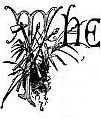 PAST of our race is
irradiated here and there by the light of science sufficiently to
enable us to form quite vivid conceptions of vanished peoples. As
the naturalist, from the inspection of a single bone, is enabled
to determine the animal from which it was derived, though there
be no longer a living representative, so the archæologist,
by the aid of fragmentary remains, is able to tell us of manners
and times now long since removed. In the words of another: "The
scientist to-day passes up and down the valleys, and among the
relics and bones of vanished people, and as he touches them with
the magic wand of scientific induction, these ancient men stand
upon their feet, revivified, rehabilitated, and proclaim with
solemn voice the story of their nameless tribe or race, the
contemporaneous animals, and physical appearance of the earth
during those prehistoric ages."2
PAST of our race is
irradiated here and there by the light of science sufficiently to
enable us to form quite vivid conceptions of vanished peoples. As
the naturalist, from the inspection of a single bone, is enabled
to determine the animal from which it was derived, though there
be no longer a living representative, so the archæologist,
by the aid of fragmentary remains, is able to tell us of manners
and times now long since removed. In the words of another: "The
scientist to-day passes up and down the valleys, and among the
relics and bones of vanished people, and as he touches them with
the magic wand of scientific induction, these ancient men stand
upon their feet, revivified, rehabilitated, and proclaim with
solemn voice the story of their nameless tribe or race, the
contemporaneous animals, and physical appearance of the earth
during those prehistoric ages."2
We have already learned that the world is full
of mysteries, and though, by the exertion of scholars, we begin
to have a clearer idea of some topics, yet our information is
after all but vague and shadowy. The amount of positive knowledge
in regard to the mysterious tribes of the older Stone Age, or the
barbarians of the Neolithic period, or the struggling
civilization of the early Metallic Ages, is lamentably deficient.
On our Western Continent we have the mysterious remains in the
gold-bearing gravels of the Pacific coast, the significance of
which is yet in dispute. We have the Paleolithic Age of Europe,
represented by the remains found in the gravels of the Delaware
at Trenton, New Jersey. When deposited there, and by what people
used, is, perhaps, still enshrouded in doubt.
Leaving now the past, expressed by geological
terms, or by periods of thousands of years, we draw near to our
own tribes, near, at least, comparatively speaking, and behold,
here, also, we discern evidence that an ancient culture, as
marked as that which built its cities along the fertile
water-courses of the Old World, had its seat on the banks of our
great rivers; that here flourished in full vigor for an unknown
length of time a people whose origin and fate are yet in doubt,
though, thanks to the combined efforts of many able men, we begin
to have clearer ideas of their social organization. We know them
only by reason of their remains, and as these principally are
mounds, we call them the "Mound Builders."
The name is not a distinguishing one in every
sense, since mankind, the world over, have been mound and pyramid
builders. The pyramids of Egypt and the mound-dotted surface of
Europe and Asia bear testimony to this saying, yet nowhere else
in the world are they more plainly divided into classes, or
marked with design than here. In some places fortified hills and
eminences suggest the citadel of a tribe or people. Again,
embankments of earth, mostly circular or square, separate and in
combination, generally inclosing one or more mounds, excite our
curiosity, but fail to satisfy it. Are these fading embankments
the boundaries of sacred inclosures, or the fortification of a
camp, or the foundations on which to build communal houses? Here
graded ways, there parallel embankments raise questions, but
suggest no positive answer. We are equally in doubt as to the
purposes for which many of the mounds were built. Some seem to
have been used as places of sepulcher, some for religious rites,
and others as foundation site of buildings. Some may have been
used as signal mounds, from which warning columns of smoke, or
flaming fires, gave notice of an enemy's approach.
Before coming to details let us, at a glance,
examine the picture as a whole. This country of ours, with its
wide plains, its flowing rivers and great lakes, is said by
scholars to have been the home of a people well advanced in the
arts of barbarian life. What connection, if any, existed between
them and the Indians, is yet unsettled. We are certain that many
years before the Spanish discovery of America they made their
settlements here, developed their religious ideas, and erected
their singular monuments. That they were not unacquainted with
war, is shown by their numerous fortified inclosures. They
possessed the elements of agriculture, and we doubt not were
happy and contented in their homes. We are certain they held
possession of the fairer portions of this country for many
years.
We must now seek to gather more particular
knowledge of them, and of the remains of their industry. We must
not forget that these are the antiquities of our own country;
that the broken archæological fragments we pick up will,
when put together, give us a knowledge of tribes that lived here
when civilization was struggling into being in the East. It
should be to us far more interesting than the history of the land
of the Pharaohs, or of storied Greece. Yet, strange to say, the
facts we have just mentioned are unknown to the mass of our
people. Accustomed to regard this as the New World, they have
turned their attention to Europe and the East when they would
learn of prehistoric times. In a general way, we have regarded
the Indians as a late arrival from Asia, and cared but little for
their early history. It is only recently that we have become
convinced of an extended, past in the history of this country,
and it is only of late that able writers have brought to our
attention the wonders of an ancient culture, and shown us the
footprints of a vanished people.
We must first try and locate the territory
occupied by the remains of the mound builders. They are not to be
found broadcast over the whole country. We recall, in this
connection, that the early civilization of the East arose in
fertile river valleys. This is found to be everywhere the case,
so we are not surprised to learn that the broad and fertile
valley of the Mississippi, with its numerous tributaries, was the
territory where these mysterious people reared their monuments
and developed their barbarian culture. Throughout the greater
portion of this area we find numerous evidences of a prolonged
occupation of the country. We are amazed at the number and
magnitude of the remains. Though this section has been under
cultivation for many years, and the plow has been remorselessly
driven over the ancient embankments, yet enough remain to excite
our curiosity and to amply repay investigation.
This portion of the United States seems to
have been the home, the seat of the mound building tribes. We can
not expect to find one type of remains scattered over this entire
section of country. Indeed, to judge from the difference of the
remains, they must have been the work of different people or
tribes, who were doubtless possessed of different degrees of
culture.3 We will notice in our
examination how these remains vary in different sections of the
country. But it is noticeable that these remains become scarce
and finally disappear as we go north, east, and west from the
great valley. Although they are numerous in the Gulf States, yet
they are not to be found, except in a few cases, in States
bordering on the Atlantic.4 Some
wandering bands, perhaps colonies from the main body of the
people, established works on the Wateree River, in South
Carolina,5 In the mountainous
regions of North Carolina occur mines of mica, which article was
much prized by the mound builders; and here also are to be found
traces of their early presence.6
We do not know of any authentic remains in New England States. In
Western New York there exists a class of remains which, though
once supposed to be the work of these people, are now generally
considered as the remains of works erected by the Indians,7 and of a similar origin appears to
have been the singular fortification near Lake Winnipiseogee, in
New Hampshire.8
We have no record of their presence north of
the great lakes. Passing now to the western part of the valley,
we do not find definite traces of their presence in Texas. On
this point, however, some authors state the contrary, apparently
basing their views on a class of mounds mentioned by Prof.
Forshey.9 But the very
description given of these mounds, and the statements as to the
immense number of them,10 seem to
show they are not the work of men.11 We do not think the West, and
especially the North-west, has been carefully enough explored to
state where they begin. It is certain that the head waters of the
Mississippi and the Missouri were thickly settled with tribes of
this people, and some writers think that they spread over the
country by way of the Missouri Valley from the North-west. Mr.
Bancroft quotes from the writings of Mr. Dean, to show the
existence of mounds and inclosures on Vancouver Island, and in
British Columbia. And the statement is made that a hundred miles
north of Victoria there is a group of mounds ranging from five to
fifty yards in circumference, and from a few feet to fifty feet
in height.12
The inclosures, however, are described as
being very similar to those in Western New York, and are probably
simply fortified sites, common among rude people the world over,
and such as were often erected by Indians. The remains on the
upper Missouri and its tributaries are very numerous, and to
judge from the brief description given us of them, they must be
very interesting.13 This section
has, however, been too little explored to speak with confidence
of these works.
As showing how much care should be exercised
in this matter, we refer to the account given by Capt. Wilkes in
his journal of the United States exploring expedition. Speaking
of the mounds on the gravelly plains between the Columbia River
and Puget Sound, he tells us that the Butte Prairies are covered
with small mounds at regular distances asunder. Some of them are
thirty feet in diameter, six or seven feet above the level of the
ground, and many thousands in number. He opened some of them, and
found a pavement of round stones, and he thought he could detect
an arrangement of the mounds in groups of five, thus. 
It was his impression that they were the works
of men, and had been constructed successively and at intervals of
several years.14 This observation
of Capt. Wilkes is referred to by many as evidence of the former
existence of Mound Builders in this section.
More careful research in recent times has
established the fact that these mounds were certainly not erected
by human hands, and no one else has been able to discover the
supposed arrangement in groups of five. The pavement of round
stones is common to the whole prairie.
But the greatest objection is the number of
the mounds. A population larger than could have found a living in
the country must have been required to erect them, unless we
assume that a great length of time was consumed in this work.
Some other explanation must be given for these mounds, as well as
for those mysterious ones mentioned by Prof. Forshey. This cut
gives us a fair idea of the scenery of this section and the
mounds.15
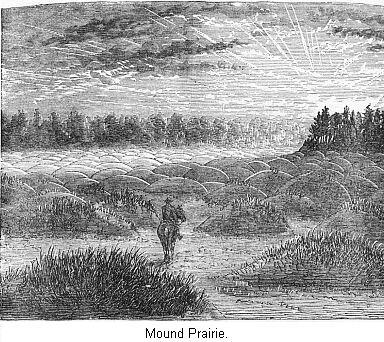
Within the area we have thus defined are
located the works of the people we call the Mound Builders. What
we wish to do is to learn all about these vanished people. A
great many scholars have written about them, and large
collections of the remains of their handiwork have been made.
There is, however, a great diversity of opinion respecting the
Mound Builders and their culture. So we see we have a difficult
subject to treat of. In order to gain a clear understanding of
it, we must describe the remains more closely. About all we can
learn of these people is from a study of their monuments. We can
not call to our aid history or tradition, or rock-carved
inscription, but must resort to crumbling mounds, broken down
embankments; study their location, and observe their forms. To
the studies in the field we must add those in the cabinet, and
examine the many objects found in and above the mounds and
earth-works, as well as the skeletons of the builders of the
works. Rightly used, we can draw from these sources much valuable
information of the people whose council-fires blazed all along
the beautiful valleys of the Ohio and Mississippi rivers in times
far removed from us.
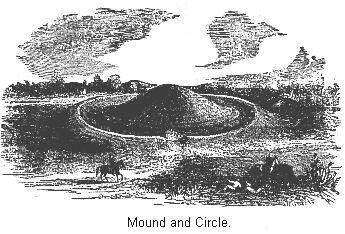
We will first speak of the simplest form of
these works, the ordinary conical mound. This is the one form
found all over the extensive area designated. They exist in great
numbers on the banks of the upper Missouri, as well as the river
bottoms of the South. This cut represents a very fine specimen of
a mound, in this instance surrounded by a circular embankment. We
must not forget that mounds are found all over the world. "They
are scattered over India, they dot the steppes of Siberia and the
vast region north of the Black Sea; they line the shores of the
Bosphorus and the Mediterranean; they are found in old
Scandinavia, and are singularly numerous in the British
Islands."16
The principle in human nature which leads to
the erection of mounds is living and active to-day. The shaft
which surmounts Bunker Hill is but a modern way of memorizing an
event which in earlier ages would have led to the erection of a
mound, and the polished monument which marks the resting place of
some distinguished man was raised for the same purpose as the
mounds heaped over the chiefs and warriors of another age. The
feeling which moves us to crown with steeples or spires our
houses of worship is evidently akin to that which induced older
races to erect a mound on which to place their temples, their
idols, and altars of sacrifice.
If mounds were the only works remaining of
these ancient people, we would not take so great an interest in
them, and, as it is, we are not to suppose that all the mounds
are the works of those people we call the Mound Builders. Recent
investigation and historical evidence unite in showing that some
comparatively recent Indian tribes formed and used mound
structures. Early explorers have left abundant testimony to show
that in many cases the Indians resorted to mound-burial. Thus, it
seems that it was the custom of the Iroquois every eighth or
tenth year, or whenever about to abandon a locality, to gather
together the bones of their dead and rear over them a mound. To
this custom, which was not confined to the Iroquois, are
doubtless to be ascribed the barrows and bone mounds which have
been found in such numbers in various parts of the country.17 Although it is well to bear these
facts in mind, yet it is not doubted that the larger number, and
especially the more massive ones, were erected by the same people
who built the other mysterious works, and so it is necessary that
they be carefully studied.

In the valley of the Ohio there have been
found a class of mounds known as Altar Mounds. These, it should
be stated, nearly always occur in or near inclosures. This cut
gives us a good idea of mounds of this kind. Near the top is seen
an instance of what is called "intrusive" burial. After the mound
was completed it had been dug into and a body buried near the
surface. This burial was evidently later in time, and had no
connection with the purpose for which the mound was originally
built. We also notice in this mound the different layers of which
it was composed. These layers are of gravel, earth, and sand, the
latter being only a few inches thick. Mounds made in this manner
are called stratified mounds, and all altar mounds are probably
of this kind. The lines of stratification have been described as
curving so as to correspond with the shape of the mound, and such
we are told is the general rule.18
The peculiar feature, however, is the altar at
the bottom of the mound, directly above the natural surface of
the ground. The small cut gives us a clear idea of the altar, the
light lines running around it showing the plan. These altars are
almost always composed of clay, though some of stone have been
discovered. They are of various shapes and sizes. We notice the
dish-shaped depression on the top of the altar. The clay of which
they are composed seems to have been moulded into shape directly
over the surface of the ground. Sometimes a layer of sand was put
down as a foundation. They are nearly always thoroughly burned,
the clay being baked hard, sometimes to the depth of fifteen or
twenty inches. This must have required intense and long continued
heat.
We are at once curious to know the object of
this altar. Within the basin-shaped depression are generally
found all manner of remains. Sometimes portions of bones, or
fragments of wood, arranged in regular order; pieces of pottery
vessels, and implements of copper and stone; spear-heads,
arrow-heads, and fragments of quartz and crystals of garnet.
Pipes are a common find, carved in miniature figures of animals,
birds, and reptiles. Two altar-mounds but recently examined near
Cincinnati had altars about four feet square that were loaded
down with ornaments.
One especially contained quantities of
ornaments of stone, copper, mica, shells, the canine-teeth of
bears and other animals, and thousands of pearls. They were
nearly all perforated, as if for suspension. Several of the
copper ornaments were covered with native silver which had been
hammered out into thin sheets and folded over the copper. One
small copper pendant seems to have been covered with a thin sheet
of hammered gold, as a small piece was still clinging to it. This
is the first example of finding native gold in the mounds.19 On this altar were also found
masses of meteoric iron, and ornaments of the same material. One
piece of mica showed the profile of a face.20
In all cases the articles found on the altars
show the action of fire. We seem justified, then, in supposing
that after the altar was formed, fires were lit on them, and into
this fire were thrown the various articles just enumerated. But
what was all this for? This will probably never be very clear to
us, beyond the fact that it was a religious rite. Portions of the
human skeleton have been found on these altars, and it has been
suggested that human victims were at times part of the sacrifice;
but as it is known that this people practised cremation, it may
be that the altars were sometimes used for that purpose, the
remains being afterwards gathered and buried elsewhere.
After the offerings had been flung into the
fire, while it was yet glowing on the altar, earth or sand was
heaped over them for a few inches, then successive layers of
earth and sand, or ashes, clay, or gravel. Sometimes the altars
were used several different times, in which case a layer of clay
several inches thick was laid over the old altar. In one case
three layers had been burned in before the final addition of
earth and sand were heaped over it. These strange monuments of a
by-gone people hint to us of mysterious rites. We wish we had
more positive knowledge of the ceremonies they commemorated; but
at present we must rest satisfied with conjecture.
The next class of mounds are known as burial
mounds, some of which are stratified, and resemble the so-called
altar mounds. A mound explored in Butler County, Ohio, had in the
center a layer of clay an inch thick, which had been burned until
it was red. Underneath this was another layer of clay, beneath
which was found charcoal, burnt cloth, and charred bones. Mr.
Foster thinks that in this mound the body was placed on a rude
altar, fires were lit, and that while yet burning, clay was
thrown over it all, and that then fires were built all over the
mound, sufficient to burn the clay for an inch in thickness.21 We have also a description of a
group of mounds explored near the Mississippi River, in which
there were evident signs of cremation. At least in several mounds
fires had been built close above the bodies. But in cremation
other victims may have been burned to accompany the departed
chiefs or warriors. In one mound evidence of such a custom was
observed.
In another mound the center was found to be a
mass of burned clay interspersed with calcined human bones. No
less than ten or fifteen bodies had been burned here. "They must
have worshiped some fierce ideal deity, and the ceremony must
have been considered of great importance to have required so many
victims." This may have been, however, nothing more than simple
cremation.22
Pidgeon has described mounds in Minnesota, in
many respects like the altar mounds. In one case he mentions
there was an altar or pavement of stone on the original surface
of the ground, a few feet above which was a layer of clay,
showing the action of fierce and long-continued fires. We
furthermore are told that cremation, especially of chiefs, was
more or less common among the Village Indians of North America,
that similar usage was observed among many of the tribes of
Mexico, and that the Mayas, of Yucatan, burnt the bodies of their
lords, and built temples over their remains. So it may be that
the altar mounds are but varieties of funeral mounds, the remains
of the bodies burned here being buried elsewhere.23
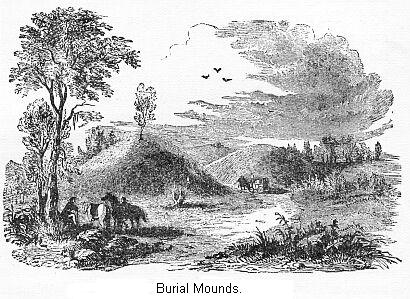
The nations that celebrated their mysteries
around these mounds have long since departed; the altar fires
long since burned low. We are not sure that we understand their
purport, but we are certain they were regarded as of great
importance, and we can readily imagine that when the fires were
lit on the altars, gathering crowds stood round, and participated
in the religious observance, throwing into the fire their most
valued ornaments, in this manner paying their last respects to
the departed chiefs and great men of their tribe.
The true burial mounds are very numerous, an
comprise by far the larger number of mounds. They are to be found
all over the Mound Builders' territory, and are about the only
class of remains found in the prairie regions of the West. From
the upper waters of the Missouri and the great lakes on the north
to the Gulf States on the south, and from west of the Mississippi
to the Alleghenies of the East, in all this vast region they are
the prevailing class of remains, and occur by hundreds, and even
thousands, along the valleys. The mounds themselves are often not
very conspicuous; as a rule they are simply heaps of dirt raised
above the surface and rounded over, and from two or three to
fifteen or twenty feet high, although many are of much larger
size. They are seldom found on the lower, or recent river
terrace, but are common on the upper terrace, and are often built
upon the high bluffs bordering the streams, where a wide stretch
of country is exposed to view. Black-bird, an Omaha chief, who
died about the year 1800, desired to be buried on a high bluff
overlooking the Missouri, so that he might see the boats passing
up and down the river. Perhaps from a similar superstitious wish
the Mound Builders sometimes chose the sites of their burial
mounds where they could watch over their country; or it may be
that the monuments over the dead were placed in such conspicuous
positions that they might be readily seen by the people.
The next cut represents an ordinary burial
mound, which was explored by tunneling in from one side. We
notice there are no different layers or stratifications in this
case. In some cases, at least, the building of such a mound
occupied several years. We can see where the dirt was thrown down
in small quantities, averaging about a peck, as if from a basket.
In one case grass had started to grow on the unfinished surface
of the mound, to be covered up by fresh dirt.24
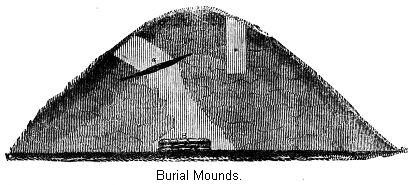
In the majority of cases the mounds contain
the remains of but one individual, with various relics of a rude
and barbarous people. Where but one body was buried, the usual
mode of procedure seems to have been to first clear a space on
the surface of the ground; the body was then placed in the center
of this prepared place, and often a rude framework of timber was
placed around it, sometimes a stone chamber was built up. Over
this the mound was erected to the desired height. This
description would apply to nearly all of the many thousands of
burial mounds in the country.
In the cut a layer of charcoal is noticed near
the top. Nearly all mounds show evidence of the existence of fire
during some period of their construction. In some cases these
fires were fierce and long continued, as if the object had been
to cremate the body. It may have been a part of their religious
belief that it was necessary to keep fires blazing on the mound
for a short length of time to keep off evil spirits, or to
comfort the soul of the departed. Such at any rate was the custom
among some Indian tribes. We are told that among the Iroquois, a
"fire was built upon the grave at night to enable the spirit to
prepare its food."25
In some cases, many individuals were buried in
the same mound. These may be communal burials, such as we have
already referred to. Mounds of this kind have been examined near
Nashville, Tennessee. One mound alone was the burial place of
over two hundred persons. Pidgeon describes some triangular
burial mounds in Minnesota, differing in shape only from the
ordinary circular mounds that belong to this division. In
general, burial mounds are not very high, yet there are
exceptions to this rule.
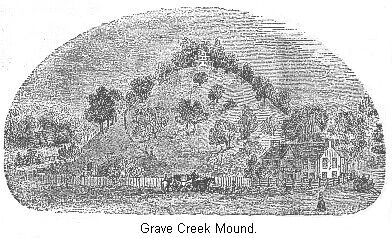
This cut represents one of the largest of
these mounds. It is situated at the junction of Grave Creek and
the Ohio River, twelve miles below Wheeling, in West Virginia. It
measures seventy feet in height, and its base is nearly one
thousand feet in circumference. An excavation made from the top
downward, and from one side of the base to the center, disclosed
the fact that the mound contained two sepulchral chambers, one at
the base and one near the center of the mound. These chambers had
been constructed of logs, and covered with stone. The lower
chamber contained two skeletons, one of which is supposed to have
been a female. The upper chamber contained but one skeleton. In
addition to these, there were found a great number of shell
beads, ornaments of mica, and bracelets of copper.26
A moment's thought will show us what a great
work such a mound must have been for a people destitute of
metallic tools and domestic animals. The earth for its
construction was probably scraped up from the surface and brought
thither in baskets. A people capable of erecting such a monument
as this, with only such scanty means at their command, must have
possessed those qualities which would sooner or later have
brought them civilization.
Another very interesting mound of this class
once stood in the city of St. Louis. The rapidly growing city
demanded its removal in 1869. It was an oblong mound, one hundred
and fifty feet long by thirty in height. In its removal it was
shown that it contained a burial chamber seventy-five feet long,
from eight to twelve feet wide, and from eight to ten feet high,
in which about thirty burials had taken place. The surface of the
ground had first been leveled, then the walls raised to the
desired height, made firm and solid, and plastered with clay.
Timbers formed the roof, over which the mound had been raised to
the desired height.
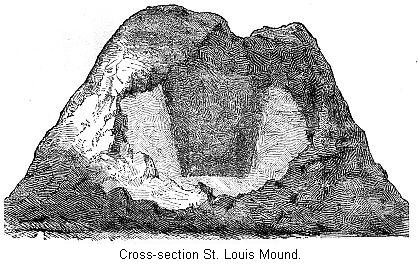
In process of time the roof decayed and fell
in, thus giving a sunken appearance to the top of the mound. This
view is a cross section of the mound as it was revealed by the
workmen. We notice where the roof has fallen in, and the outline
of the interior chamber. This burial chamber was perhaps an exact
model of the cabins in which the people lived. Can it be that
this mound was the final resting place of some renowned chief,
and that the other bodies were those of his attendants sent to
accompany him to the other world? This is perhaps as reasonable a
conjecture as any. Certain it is that this tumulus and that at
Grave Creek were fit pyramids for the Pharaohs of the New
World.
It is not to be supposed that the mounds were
the sole cemeteries of the people who built them. Like the
barrows of Europe, they were probably erected only over the
bodies of the chiefs and priests, the wise men, and warriors of
the tribe. The amount of work required for the erection of a
mound was too great to provide one for every person. The greater
number of the dead were deposited elsewhere than in mounds, but
it is doubtful whether we can always distinguish the prehistoric
burial places from those of the later Indians. An ancient
cemetery, discovered near Madisonville, Ohio, proved to be a most
interesting find, as it was thought to be a burial place of the
Mound Builders,27 but it seems
there is strong doubt on this point. One writer thinks this was a
cemetery of the Erie tribe of Indians, and not very ancient in
date.28
In Tennessee are to be found numerous burial
places known as the stone-grave cemeteries. Stone graves of a
similar character are found in Kentucky, Ohio, and Missouri.
These are as yet but few facts which can be used as indicating
that all the stone graves are of one people. Many of these
cemeteries are of great antiquity, while similar stone graves are
of quite recent date. In some places the cemeteries cover very
large areas.
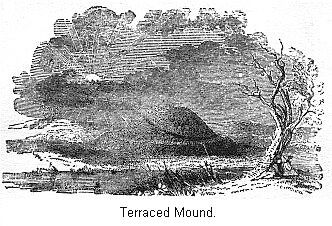
We have now to describe a class of mounds that
are always regarded with great interest, as a number of our
scholars think they see in them the connecting link between the
remains in this country and those of Mexico and the South. These
are generally known as "temple mounds," from the common
impression that they were sites of temples or public buildings.
In general terms, mounds of this class are distinguished by their
large size and regularity of form, and they always have a flat or
level top. On one side there is generally a graded way leading up
to the summit, in some instances several such methods of
approach. Sometimes the sides of the mound are terraced off into
separate stages.29
We have already noticed that different
sections of country are distinguished by different classes of
mound remains. In the present State of Ohio are found many altar
mounds and inclosures. In the West are large numbers of burial
mounds, but the so-called temple mounds are most numerous in the
South. At one place in Wisconsin is found a low embankment
inclosing four low mounds with leveled tops. But the resemblance
between these and the regular temple mounds is certainly slight.
Only a few instances of these flat-topped mounds are found in
Ohio. Of these the still existing "elevated squares" at Marietta
are good examples.
 This cut represents the mound preserved in the park at Marietta.
It is ten feet high, one hundred and eighty-eight feet long, by
one hundred and thirty-two feet wide. The platform on the top has
an area of about half an acre. Graded ways lead up on each of the
four sides. These grades are twenty-five feet wide, and sixty
feet long.30
This cut represents the mound preserved in the park at Marietta.
It is ten feet high, one hundred and eighty-eight feet long, by
one hundred and thirty-two feet wide. The platform on the top has
an area of about half an acre. Graded ways lead up on each of the
four sides. These grades are twenty-five feet wide, and sixty
feet long.30
As we approach the Gulf States, these platform
mounds increase in number. The best representative of this class,
the most stupendous example of mound builders' work in this
country, is situated in Illinois, not far from St. Louis. The
mound and its surroundings are so interesting that they deserve
special mention. One of the most fertile sections of Illinois is
that extending along the Mississippi from the Kaskaskia to the
Cahokia river, about eighty miles in length, and five in breadth.
Well watered, and not often overflowed by the Mississippi, it is
such a fertile and valuable tract that it has received the name
of the "Great American Bottom." It is well known that the Mound
Builders chose the most fertile spots for their settlements, and
it is therefore not surprising to find the evidence that this was
a thickly settled portion of their territory. Mr. Breckenridge,
writing in 1811, says: "The great number of mounds, and the
astonishing quantity of human bones, everywhere dug up or found
on the surface of the ground, with a thousand other appearances,
announces that this valley was at one time filled with
habitations and villages. The whole face of the bluff, or hill,
which bounds it on the east, appears to have been a continuous
burying ground."31
Mounds are numerous in this section. We learn
that there are two groups of mounds or pyramids, one about ten
miles above the Cahokia, and the other about the same distance
below it, more than one hundred and fifty in all. Speaking of the
group above the Cahokia, Mr. Breckenridge says: "I found myself
in the midst of a group of mounds mostly of a circular shape,
and, at a distance, resembling enormous hay-stacks scattered
through a meadow. One of the largest which I ascended was about
two hundred paces in circumference at the bottom, the form nearly
square, though it had evidently undergone considerable alteration
from the washing of rains. The top was level, with an area
sufficient to contain several hundred men." He represents the
view from the top of the mound to be a very extensive and
beautiful one. From this elevation he counted forty-five mounds
or pyramids, besides a great number of small artificial
elevations. This group was arranged in the form of a semicircle,
about a mile in extent, the open space being on the river.
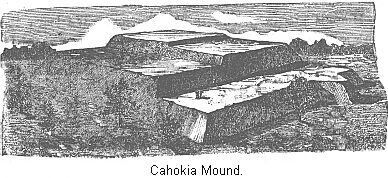
Three miles above occurs the group in which is
found the famous big mound.32
This cut gives us a good idea of the mound as it was in its
perfect state. All accounts given of this mound vary. From a cut
of the model, as prepared by Dr. Patrick, the area of the base is
a trifle over fifteen acres.33
The ascent was probably on the south side of the mound, where the
little projection is seen. The first platform is reached at the
height of about fifty feet. This platform has an area of not far
from two and four-fifth acres. Large enough for quite a number of
houses, if such was the purpose for which this mound was erected.
The second platform is reached at about the height of
seventy-five feet, and contains about one and three-fourth acres.
The third platform is elevated ninety-six or ninety-seven feet,
while the last one is not far from one hundred feet above the
plain. The area of the last two is about three-fourths of an acre
each. The areas of all the platforms are not far from six acres.
We require to dwell on these facts a moment before we realize
what a stupendous piece of work this is. The base is larger than
that of the Great Pyramid,34 and
we must not lose sight of the fact that the earth for its
construction was scraped up and brought thither without the aid
of metallic tools or beasts of burden, and yet the earth was
obtained somewhere and piled up over an area of fifteen acres in
one place to a height of one hundred feet, and even the lowest
platform is fifty feet above the plain. Some have suggested that
it might be partly a natural elevation. There seems to be,
however, no good reason for such suggestions.
What motive induced the people to expend so
much labor on this mound? It is not probable that this was a
burial mound, though it may ultimately prove to be so. The most
probable supposition is that the mound was erected so as to
secure an elevated site, perhaps for purpose of defense, as on
these platforms there was abundant room for a large village, and
an elevation or height has always been an important factor in
defenses. In this connection, Prof. Putnam has called our
attention to a fact which indicates that a very long time was
occupied in the construction of the mound, and further, that a
numerous population had utilized its platforms as house
sites—that is, that "everywhere in the gullies, and over
the broken surface of the mounds, mixed with the earth of which
it is composed, are quantities of broken vessels of clay, flint
chips, arrow-heads, charcoal, bones of animals, etc., apparently
the refuse of a numerous people." The majority of writers,
however, think that this elevated site, obtained as the result of
so much labor, was utilized for important public buildings,
presumedly the temple of their gods, and no one can help noticing
the similarity between this structure and those raised by the
ancient Mexicans for both religious purposes and town sites.
Mr. Foster thinks that "upon this platform was
reared a capacious temple, within whose walls the high-priests
gathered from different quarters at stated seasons, celebrated
their mystic rites, while the swarming multitudes below looked up
with mute adoration."35 Mr.
Breckenridge, whose writings we have already referred to, at the
time of his first visit, "everywhere observed a great number of
small elevations of earth, to the height of a few feet, at
regular distances apart, which appeared to observe some order:
near them pieces of flint and fragments of earthen vessels." From
this he concludes that here was a populous town, and that this
mound was a temple site. It is doubtful whether we shall ever
pierce the veil that lies between us and this aboriginal
structure. The pyramids of the Old World have yielded up their
secret, and we behold in them the tombs of Egypt's kings. But
this earthen pyramid on the western prairie is more involved in
mystery, and we do not know even its builders. If the result of
religious zeal, we may be sure that a religion which exacted from
its votaries the erection of such a stupendous piece of work was
one of great power.
As before remarked, "temple mounds" increase
in numbers and importance as we go south. In Kentucky they are
more frequent than in the States north of the Ohio River, and in
Tennessee and Mississippi they are still more abundant.36 We also learn that they are often
surrounded, or nearly so, with moats or ditches, as if to fortify
their location. Our next cut illustrates such an
arrangement—a circular wall of earth four feet high and two
thousand three hundred feet in circumference, incloses four
mounds, two of which are temple mounds. According to the late
Prof. Forshey, temple mounds abound in Louisiana. He described a
group situated in Catahoola County, in which the principal mound
has a base of more than an acre, a height of forty-two feet, and
the upper platform an area of nearly one-third of an acre. The
smaller mounds are arranged around this larger one. This group is
defended by an embankment. From this point for a distance of
twenty miles along the river, are scattered similar groups of
mounds; in all cases the smaller ones arranged around the larger
one, which is presumably the site of a temple.

A digression right here may not be devoid of
interest. We are not sure but that the dim, uncertain light of
history falls on the origin of this group of mounds. When the
French first commenced their settlement in the lower Mississippi
Valley, the Natchez Indians was the most powerful tribe in all
that section. In the course of time, wars ensued between them and
the French, and in the year 1730 they fled into Upper Louisiana,
and settled at the place where these mounds are now found. But
the French followed them a year or so afterwards, and nearly
exterminated. them. Some of our scholars think that they erected
these mounds.37 The historian of
that epoch simply says they had "built a fort there." It is
however questioned whether they had time to build works of such
magnitude. But they were both a mound-building and a mound-using
people, and we are not prepared to say how long it would take
them to do the work, until we know the number engaged, methods
employed, and other considerations.38 If they did not build these works,
they doubtless cleared them of trees and utilized them; and this
place was therefore the scene of the final downfall of the
Natchez—a people we have every reason to regard as
intimately connected with the prehistoric mound-building
tribes.
The largest temple mound in the South is near
Seltzertown, Mississippi. Its base covers about six acres, and it
rises forty feet. This slope was ascended by means of a graded
way. The summit platform has an extent of nearly four acres. On
this platform three other mounds had been reared—one at
each end, and a third in the center. Recent investigation by the
Bureau of Ethnology have shown that the base of this mound is a
natural formation. Lumps of sun-dried, or partially burnt clay,
used as plastering on the houses of the Mound Builders, gave rise
to a sensational account of a wall of sun-dried bricks two feet
thick, supporting the mound on the northern side.39 The famous Messier Mound, in Georgia,
is said to reach a height of ninety-five feet. But a large part
of this elevation is a natural eminence; the artificial part is
only a little over fifty feet.
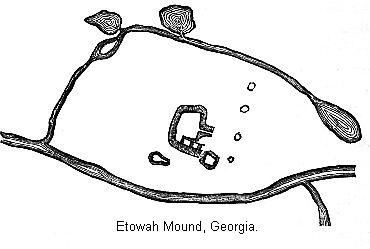
A work of unusual interest occurs on the
Etowah River, Georgia. This cut gives us a plan of the work. We
notice, first of all, the moat or ditch by which they fortified
their position. The ditch is still from five to twenty-five feet
deep, and from twenty to seventy-five feet wide. It connects
directly with the river at one end, but stops short at the other.
It surrounds nearly fifty acres of land. At two points we notice
reservoirs, each about an acre in size, and an average depth of
not less than twenty feet. At its upper end is an artificial
pond. This ditch, with its reservoirs and pond, is no slight
work. The large mound seen in the center of the space is one of
the largest of the temple mounds. Its shape is sufficiently shown
in the cut. The height of the mound is sixty-five feet. We call
especial attention to the series of terraces leading up the south
side of the mound. Graded ways afford means of access from one
terrace to the other. A pathway is also seen on the eastern
side.
To this group of works an interest attaches
similar to that of the group of works mentioned in Louisiana. We
are not certain but that we catch a glimpse of it while it was
yet an inhabited Indian town. This is contained in the brief
accounts we have of the wanderings of the unfortunate De Soto and
his command. One of the chroniclers of this expedition La Vega,
describes one of the towns where the weary Spaniards rested, and
which we are sure was somewhere in Northern Georgia, in such
terms, mentioning the graded way leading to the top, that Prof.
Thomas, who has spent some time in this investigation, thinks his
description can apply only to the mound under consideration.40 Whether this conclusion will be
allowed to stand, remains to be seen. But, if true, then the
darkness which rests upon this aboriginal structure lifts for a
moment and we see around it a populous Indian town, able to send
five hundred warriors to battle. The Spaniards marched on to
sufferings and death, and darkness again closed around the Etowah
Mound. When the Europeans next beheld it around it was the silent
wilderness; the warriors had departed; the trees of the forest
overspread it.
We have now described the principal mound
structures, and shown the different classes into which they are
divided. But a large class of mounds are found scattered all
through the Mound Builders' territory that were probably used as
signal mounds. Burial mounds were also often used for this
purpose.41 This was because their
location was always very favorable for signal purposes. Signaling
by fire is a very ancient custom. The Indians on our western
plains convey intelligence by this means at the present day. Some
tribes use such materials as will cause different shades of
smoke, using dried grass for the lightest, pine leaves for the
darkest, and a mixture for intermediate purposes. They also vary
the signal by letting the smoke rise in an unbroken column, or
cover the fire with a blanket, so as to cause puffs of smoke. The
evidence gathered from the position of the mounds, and traces of
fire on their summit, is that the Mound Builders had a very
extensive system of signal mounds.
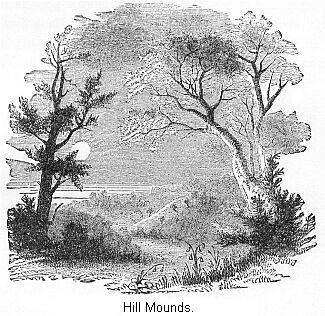
To illustrate this system, we would state that
the city of Newark, Ohio, was the site of a very extensive
settlement of the Mound Builders. This settlement was in a
valley, but on all the surrounding hills were located signal
mounds. And it is further stated that lines of signal mounds can
be traced from here as a center to other and more distant points.
The large mound at Mt. Vernon, twenty miles to the north, was
part of this system. As the settlements of the Mound Builders
were mostly in river valleys, we would expect to find all along
on the bluffs fronting these valleys traces of signal mounds. In
the Scioto Valley, from Columbus to Chillicothe, a distance of
about forty miles, twenty mounds "may be selected, so placed in
respect to each other that it is believed, if the country was
cleared of forests, signals of fire might be transmitted in a few
minutes along the whole line." Some think the chain is much more
extensive than this, and that the whole Scioto Valley, from
Delaware County to Portsmouth, was so provided with mounds that
signals could be sent in a very few minutes the whole distance.42
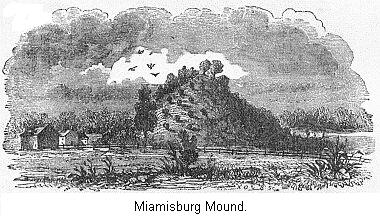
The valley of the Miami River was equally well
provided with signal mounds. This great mound, at Miamisburg,
Ohio, rising to the height of sixty-eight feet, was one of the
chain by which signals were transmitted along the valley. Not
only was each river valley thus provided, but there is evidence
that communication was established between different river
systems, so we can easily see how quickly the invasion of their
country by an enemy from any quarter would become known in widely
scattered sections. Immediately across the river from
Chillicothe, Ohio, on a hill nearly six hundred feet high, was
located a signal mound. A fire built upon it would be visible
twenty miles up the valley, and an equal distance down. It would
be also visible far down the valley of Paint Creek. Some think
that such a system of lofty observatories extended across the
whole State of Ohio, of Indiana, and Illinois, the Grave Creek
mound, on the east, the great mound at Cahokia, on the west, and
the works in Ohio filling up the line. We do not believe,
however, it is safe to draw such conclusions. It is doubtful
whether there was any very close connection between the tribes in
these several sections.
In the State of Wisconsin are found some of
the most interesting remains of the Mound Builders. They are so
different from the ordinary remains found elsewhere that we must
admit that the people who built them differed greatly from the
tribes who built the great temple mounds of the South, or the
earthworks of Ohio. The remains in Wisconsin are distinguished
not by their great size or height, but by their singular forms.
Here the mound building instincts of the people were expressed by
heaping up the earth in the shape of animals. What strange fancy
it was that led them to mould the figures on the bluffy banks of
the rivers and the high lands about the lakes of their country,
we shall perhaps never know. That they had some design in this
matter is, of course, evident, and if we would try and learn
their secret, we must address ourselves to a study of the
remains.
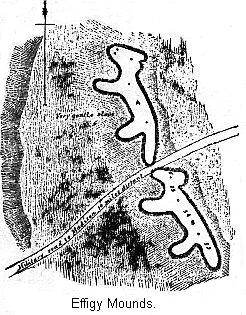 Effigy mounds are almost exclusively confined to the State of
Wisconsin. We, indeed, find effigy mounds in other sections, but
they are of rare occurrence.43
They, however, show that the same reasons, religious, or
otherwise, exists in other localities, while in the area covered
by the southern portion of the State of Wisconsin it found its
greatest expression. This cut affords us a fair idea of effigy
mounds. Here are seen two animals, one behind the other. On paper
we can readily see the resemblance. Stretched out on the ground,
and of gigantic proportions, the resemblance is not so marked,
and some might fail to notice it at first sight. Either of those
figures is over one hundred feet long, and about fifteen feet
wide. With few exceptions, effigy mounds are inconsiderable in
height, varying from one to four feet. These mounds have been
carefully studied of late years, and there is no doubt that in
many instances we can distinguish the animals represented.
Effigy mounds are almost exclusively confined to the State of
Wisconsin. We, indeed, find effigy mounds in other sections, but
they are of rare occurrence.43
They, however, show that the same reasons, religious, or
otherwise, exists in other localities, while in the area covered
by the southern portion of the State of Wisconsin it found its
greatest expression. This cut affords us a fair idea of effigy
mounds. Here are seen two animals, one behind the other. On paper
we can readily see the resemblance. Stretched out on the ground,
and of gigantic proportions, the resemblance is not so marked,
and some might fail to notice it at first sight. Either of those
figures is over one hundred feet long, and about fifteen feet
wide. With few exceptions, effigy mounds are inconsiderable in
height, varying from one to four feet. These mounds have been
carefully studied of late years, and there is no doubt that in
many instances we can distinguish the animals represented.
We learn, then, that tribes formerly living in
Wisconsin had the custom of heaping up the earth in the shape of
the various animals peculiar to that section. But no effigies are
found of animals that have since become extinct, or of animals
that are to be found only in other lands.
 Our next cut represents the famous elephant mound of Wisconsin,
on the strength of which a number of fair theories have been
given relating to the knowledge of the mastodon by the builders
of the mound, and its consequent antiquity. It now bears some
resemblance to an elephant, but we learn that the trunk was
probably produced by the washing of the banks and, from the same
cause, a projection above the head, supposed to represent horns,
has disappeared. Taking these facts into consideration, it is
quite as likely that it represented a buffalo.44 One writer even thinks he found a
representation of a camel, but the fact is, the more these effigy
mounds are studied, the more certain are we that they are
representations of animals formerly common in that region.
Our next cut represents the famous elephant mound of Wisconsin,
on the strength of which a number of fair theories have been
given relating to the knowledge of the mastodon by the builders
of the mound, and its consequent antiquity. It now bears some
resemblance to an elephant, but we learn that the trunk was
probably produced by the washing of the banks and, from the same
cause, a projection above the head, supposed to represent horns,
has disappeared. Taking these facts into consideration, it is
quite as likely that it represented a buffalo.44 One writer even thinks he found a
representation of a camel, but the fact is, the more these effigy
mounds are studied, the more certain are we that they are
representations of animals formerly common in that region.

The manner in which they represented the
various animals is full of interest to us. It has been discovered
that they worked on a system. The last cut represents a group of
three animals discovered a few miles from the Blue Mounds in Dane
County. We notice at once a difference between the central
animal, with a tail, and the other two. It will also be observed
that the animals are represented in profile, with only two
projections for legs. They are never separated so that we can
distinguish the two front and the two hind feet. Animals so
figured are the bear, fox, wolf, panther, and others. Grazing
animals, such as the buffalo, elk, and deer, are represented with
a projection for horns. In the last cut the other two animals are
buffaloes. In various ways the particular kind of animal can
nearly always be distinguished.45
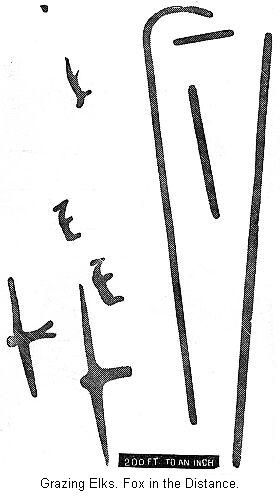
The preceding cut represents two elks grazing,
and a fox in the distance. The long embankments of earth at one
side are considered by Mr. Peet as in the nature of game drives.
But we call attention to the expressiveness with which these
figures are delineated. What could be more natural than the
quietly grazing elks, with the suspicious prowling fox in the
distance. In the cut we also see two cross-shaped figures. This
was their method of representing birds, a projection on each side
of a central body denoting wings. These figures are often very
expressive.

In this cut we have no difficulty in
recognizing an eagle. It is represented as soaring high in the
air. On the bluffs above it is a wolf effigy, and several conical
and long mounds. In the cut preceding this the eagle and the hawk
are hovering over the feeding elks, while in this cut a flock of
hawks are watching some buffaloes feeding in the distance. This
group of effigies was found on the banks of the Kickapoo
River.

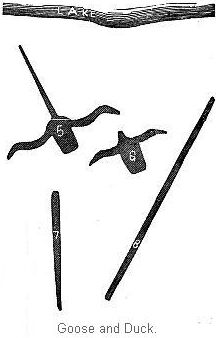 Our next cut represents a wild goose with a long neck and beak
followed by a duck with a short neck, flying towards the
lake.
Our next cut represents a wild goose with a long neck and beak
followed by a duck with a short neck, flying towards the
lake.
Water-loving animals, such as salamanders and
turtles, are represented in still another way, two projections on
each side of a central figure. The next following cut represents
a turtle. The tail was not always added. The salamander closely
resembles the turtle, but notice the difference in the body, and
still different is the cut of the musk-rat (see later). Fishes
are figured as a straight embankment of earth tapering to a
point.

The same system that was observed in the
location of signal mounds is to be noticed in the arrangements of
these groups of effigy mounds. They are not alone. One group
answers to another on a distant hill, or is in plain view of
another group in the valley below. Distant groups were so
related, each commanding a wide extent of country, and thus group
answers to group, and mound to mound, for miles away, making a
complete system throughout the region.
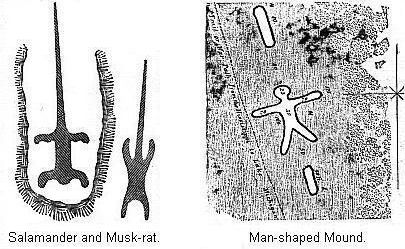
We notice this as to the location of the
mounds. When we examine the mounds themselves we observe no
little skill in the way they represent the animals. They often
impressed on them something more than mere animal resemblances.
"There are groups where the attitudes are expressive of a varied
action. Certain animals, like the weasel or mink, being seen with
a bird so near that, apparently, it might be caught by a single
spring; and still others, like the wolf or wild-cat, are arranged
head to head, as if prepared for combat; and still others, like
the squirrel or coon, are in the more playful attitudes,
sometimes apparently chasing one another over hill or valley; and
again situated alone, as if they had just leaped from some tree,
or drawn themselves out of some den or hole."46
Nor is the effigy of the human form wanting.
It is found in several localities throughout the State. This cut
shows us one such effigy. This was the beginning of a long train
of animal mounds, presumably representing bears, found near the
Blue Mounds, Wisconsin.47 We can
not observe that any more importance was ascribed to the effigy
of a human being than to that of an animal.
In casting about for suitable explanation for
the erection of these animal mounds, we find ourselves lost in
conjecture as to the motive which induced these people to prepare
these earthen effigies. We may be sure that it was for some other
reason than for amusement, or to give exercise to an artistic
feeling. Only in very few instances do we detect any arrangements
which would imply that they were in the nature of defenses. In
some cases the effigies are so arranged as to form a sort of
inclosure, some portion of the figure being prolonged to an
unusual extent and thus inclosing a space that may have been
utilized for a village site. This group on the Wisconsin River
illustrates this point. Here the area thus partially inclosed, is
about an acre. It is a singular fact that these inclosures are
almost always triangular in shape.48 But it is manifest that a simple earth
wall would serve for defense much better than these forms. They
probably were not burial mounds, as few contain human remains,
and it is not yet certain that these remains were not intrusive
burials.49 It seems, therefore
that they must have been in some manner connected with the
religious life of the people.
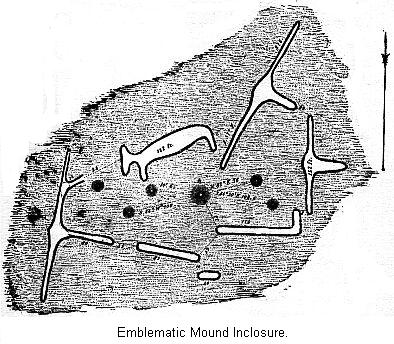
If we examine the various groups scattered
throughout the State, this belief is strengthened. It is found,
for instance, in nearly every group, that some one effigy is the
principal one, and is placed in a commanding position, about
which the other forms are arranged. It is also thought that the
same effigy is the principal or ruling effigy over a wide
district. In illustration of this, it can be stated that in the
south-eastern part of the State the turtle is always the ruling
effigy. In any group of effigies it is the principal one. It
seems to watch over and protect the others. In subordination to
it are such forms as the lizard, hawk, and pigeon. Passing to the
North, the turtle is no longer the important figure. It is
replaced by the wolf, or wild-cat. This is now the principal
form, and if the turtle is sometimes present, it is of less
importance.
So marked is the fact we have just stated that
Mr. Peet says, "that sometimes this division assumes almost the
character of a river system, and thus we might trace what seems
to be the beginning in this country of that which prevailed on
classic soil and in Oriental regions—namely, river gods and
tutelar divinities of certain regions, each tribal divinity
having its own province, over which it ruled and on which it left
its own form or figure as the seal of its power and the emblem of
its worship."50
Looking for some explanation of this, we may
find a key in the known customs of various Indian tribes, and the
lower races of men. It is known that a tribe of Indians is
divided into smaller bands, which are called gens or clans. A
gens may consist of several hundred persons, but it is the unit
of organization. It takes the place of a family among civilized
people. These various bands are generally named after some
animal. In the beginning these names may have been of no special
significance, but in course of time each band would come to
regard themselves as descendants of the animal whose name they
bore. Hence the animal itself would be considered sacred in their
eyes, and its life would seldom be taken by members of that
gens.
The animal thus honored by the gens was, in
the Indian dialect, the totem of the clan. This organization and
custom we find running all through the Indian tribes. In many
tribes the Indians were wont to carve a figure of their totem on
a piece of slate, or even to carve a stone in the shape of the
totem, which carved or sculptured stone they wore as an ornament,
or carried as a charm to ward off evil and bring them good
luck.51 We need only suppose that
this system was very fully developed among the Mound Builders of
Wisconsin, to see what important bearing it has on these effigy
mounds.
A tribe located on one of the fertile river
valleys of Wisconsin was composed of various gens or clans. On
some common point in proximity to their villages, or some spot
which commanded a wide view of the surrounding country, each gens
would rear an effigy of its totem, the animal sacred to them. In
every tribe some gens would be the most powerful, or for some
cause the most respected, and its totem would be given in the
largest effigy, and would be placed in the most commanding
position. In a different locality some other tribe would be
located, and some other totem would be regarded as of the most
importance.
In this light effigy-mounds are not mere
representatives of animal forms. They are picture-writings on a
gigantic scale, and are the source of much true history. They
tell us of different tribes, the clans which composed them, the
religious beliefs, and the ruling gens of the tribe.
Contemplating them, we seem to live again in the far-off past.
The white man disappears; waving forests claim their ancient
domain, and the rivers, with a more powerful current, roll in
their olden channels. The animals whose forms are imaged here, go
trooping through the forest or over the fertile bottom lands. The
busy scenes of civilization give place to the placid quiet of
primeval times, and we seem to see peaceful tribes of Mound
Builders paying a rude veneration to their effigy-gods, where now
are churches of a more soul-satisfying religion.
But there is still another point to be learned
from an examination of these ancient mounds. Not only are they
totems of the tribes, but they were looked on in some sense as
being guardian divinities, with power to protect the homes of the
tribe. This is learned by studying the location in which they are
placed. They occupy all points of observation. In other parts of
the Mound Builders' country, wherever we find signal-mounds we
find corresponding positions in Wisconsin occupied by groups of
effigy-mounds, or if one only is present, it is always the one
which, from the considerations we have stated, was regarded as
the ruling effigy of that section. It is as if their builders
placed them as sentinels to guard the approaches to their homes,
to give warning of the arrival of hostile bands. This is further
borne out by finding that mounds placed in such positions
frequently show evidence of the action of intense fire, and so we
conclude they were used as signal stations also. So we need not
doubt but that the region thus watched over by these
effigy-mounds, group answering to group along the river banks, or
in the valleys below, was at times lit up by the signal fires at
night; or the warning column of smoke by day betokening the
presence of dancer.52
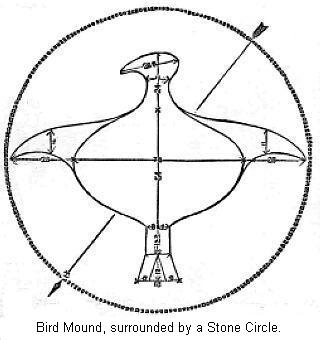
Before leaving the subject of effigy-mounds,
we must refer to some instances of their presence in other
localities. This cut is an eagle effigy discovered in Georgia.
Only one other instance, also occurring in Georgia, is known of
effigy-mounds in the South. Measured from tip to tip of the
wings, the bird, in this case, is one hundred and thirty-two
feet. This structure is composed of stones, and a singular
feature is the surrounding circle of stone.53

Several examples of effigy-mounds are found in
Ohio. The most notable one is that known as the Great Serpent
Mound, in Adanis County. We give an illustration of it. The
entire surrounding country is hilly. The effigy itself is
situated on a tongue of land formed by the junction of a ravine
with the main branch of Brush Creek, and rising to a height of
about one hundred feet above the creek. Its form is irregular on
its surface, being crescent-shaped, with the point resting to the
north-west. We give in a note some of the dimensions. The figure
we give of this important effigy is different from any heretofore
presented. We are indebted for the plan from which the drawing
was made to Rev. J. P. MacLean, of Hamilton, Ohio. Mr. MacLean is
a well-known writer on these topics. During the Summer of 1884,
while in the employ of the Bureau of Ethnology, he visited the
place, taking with him a thoroughly competent surveyor, and made
a very careful plan of the work for the Bureau. All the other
figures published represent the oval as the end of the works.
Prof. Putnam, who visited the locality in 1883, noticed, between
the oval figure and the edge of the ledge, a slightly raised,
circular ridge of earth, from either side of which a curved ridge
extended towards the sides of the oval figure. Mr. MacLean's
researches and measurements have shown that the ridges last
spoken of are but part of what is either a distinct figure or a
very important portion of the original figure. As figured, it
certainly bears a very close resemblance to a frog, and such Mr.
MacLean concludes it to be.
There is both a similarity and a difference
between this work and those of Wisconsin. The fact that it occurs
isolated, the other effigies in Ohio being many miles away, shows
that some special purpose must have been subserved by it. There
the great numbers gave us a hint as to their purpose. In this
case, however, nearly all observers conclude that it was a
religious work. Mr. MacLean, after describing these three
figures, propounds this query: "Does the frog represent the
creative, the egg the passive, and the serpent the destructive
power of nature?" Not a few writers, though not acquainted with
the presence of the frog-shaped figure, have been struck with the
combination of the egg and the serpent, that plays such an
important part in the mythology of the Old World. We are told
that the serpent, separate or in combination with the circle,
egg, or globe, has been a predominant symbol among many primitive
nations. "It prevailed in Egypt, Greece, and Assyria, and entered
widely into the superstitions of the Celts, the Hindoos, and the
Chinese." "Wherever native religions have had their scope, this
symbol is sure to appear."54
Even the Indians have made use of this symbol.
On Big Medicine Butte, in Dakota Territory, near Pierre, is a
train of stones arranged in the form of a serpent, which is
probably the work of the Sioux Indians. Around about on the hill
is the burying-ground of their chiefs. This was to them sacred
ground, and no whites were allowed near. The stones are about the
size of a man's head, and are laid in two rows, from one to six
feet apart. The length in all is three hundred and fifty feet,
and at the tail, stones, to represent rattles, are rudely carved.
The eyes are formed by two big red bowlders. No grass was allowed
to grow between the two rows of stone.55
It seems reasonable to suppose that the few
isolated effigy mounds we have outside of Wisconsin were built to
subserve a different purpose than those in that State. Mr. Peet
has made some remarks on their probable use that seem to us to
cover the ground, and to do away with any necessity of supposing
on the part of its builders an acquaintance with Old World
mythologies. Nature worship is one of the earliest forms of
worship. The prominent features of a landscape would be regarded
as objects of worship. Thus, for example, the island of Mackinac
resembles in its outline the shape of a turtle; so the island was
regarded as sacred to the turtle, and offerings were made to it.
A bluff on the same island at a distance resembles a rabbit;
accordingly, it was called by that name, and offerings were made
to it. It is quite natural that the effigy-mound builders should
seek to perpetuate by effigy some of these early traditions.
In the case of the Big Serpent mound this
point is worth considering. The ridge on which it stands is not
only in the midst of a wild, rough region, but is so situated
that it commands a wide extent of country. In shape this tongue
of land is also peculiar. It is a narrow, projecting headland,
and would easily suggest the idea of a serpent or a lizard.
"This, with the inaccessibility of the spot, would produce a
peculiar feeling of awe, as if it were a great Manitou which
resided there; and so a sentiment of wonder and worship would
gather around the locality. This would naturally give rise to a
tradition, or would lead the people to revive some familiar
tradition and localize it."56 The
final step would be to make an effigy.
It seems to us very hazardous to draw any
conclusions as to the religious beliefs of the Mound Builders
from this effigy, or combinations of effigies. It also seems to
us reasonable to suppose that but one figure was intended to be
represented. A very slight prolongation of the serpent's jaws and
the limbs of the frog would connect them, in which case we would
have some amphibious creature with an unduly extended tail, or
perhaps a lizard. We must remember that the whole figure has been
plowed over once or twice, so that we are not sure of the
original outlines. We can not tell why they should represent a
portion of the body as hollow, but neither can we tell why the
head of the supposed serpent should be represented as hollow. We
do not find any important earth-works near here. The hill on
which it is placed commands a very extensive view of the
surrounding country. Within the oval a pile of stones showed
evidence of a long-continued fire, which would indicate that this
was also a signal-mound. Prof. Putnam thinks it probable that
there was a burial place between it and the large conical mound
not far away.57
In the vicinity of Newark, Ohio, are two
examples of effigy mounds. This cut represents what is called the
alligator mound, but it is probably the effigy of a lizard. The
position which this mound occupies is significant. It is on the
very brow of a hill about two hundred feet high, which projects
out into a beautiful valley. The valley is not very wide.
Directly across was a fortified camp, in the valley below it was
a circular work, and a short distance below on another projecting
headland was a strongly fortified hill. The great works at Newark
were six miles down the valley, but were probably in plain view.
That it was perhaps a signal station, is shown by the presence of
traces of fire.
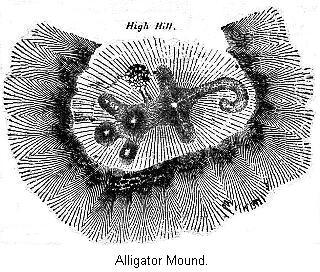
The length of this effigy is two hundred and
five feet, the breadth of the body at its widest part, twenty
feet, average height about four feet.58 The effigy mounds of Wisconsin, and
the other few examples mentioned, are among the most interesting
objects of aboriginal work. Except in a few favored instances,
they are rapidly disappearing. To the leveling influence of time
is added the assistance of man, and our knowledge of them will
soon be confined to existing descriptions, unless something is at
once done to preserve them from destruction. Interesting mementos
of a vanished race, we turn from their contemplation with a sigh
of regret that, in spite of our efforts, they are still so
enwrapped in doubt.
Mounds and effigies by no means complete the
description of Mound Builders' remains. One of the most
interesting and mysterious class of works is now to be described.
Early travelers in Ohio came here and there upon embankments,
which were found to inclose tracts of land of various sizes. It
was noticed that the embankments were often of the form of
perfect circles, or squares, or sometimes octagons, and very
often combinations of these figures. It was further evident that
the builders sought level, fertile lands, along the various river
courses. They very seldom built them on undulating or broken
ground. Often have the very places where civilized man has laid
the foundation of his towns proved to be the sites of these
ancient works of the Mound Builders, and thus it has happened
that many of the most interesting works of antiquity have been
ruthlessly removed to make way for the crowded streets and busy
marts of our own times.
The larger number of inclosures are circular,
often of a small size. Where they occur separately they either
have no gateway, or but one. Sometimes the circles are of very
large size, surrounding many acres. Sometimes, though not very
often, a ditch was also dug inside the embankment. This last
circumstance is by many regarded as a strong proof that the
primary object of these circles was not for defense.59 But an inclosure of this kind, even
with the ditch on the inside, if surmounted by a row of pickets
or palisades, would prove a strong position against Indian foes
armed with bow and arrow. The Mandans constructed defenses of
this kind around their villages.60 As to the original height of the
walls, in the majority of cases it was not very great, generally
from three to seven feet.
It is estimated that in Ohio alone there are
fifteen hundred inclosures, but a large number of them have
nothing especially worthy of mention. Some, however, are on such
a large scale that they call from all more than a passing glance.
In contemplating them, we feel ourselves confronted by a mystery
that we can not explain. The ruins of the old world excite in us
the liveliest feeling of interest, but we know their object,
their builders, and their probable antiquity. The mazy ruins at
Newark, and other places in Ohio, also fill the mind with
astonishment, but in this case we are not certain of their
antiquity, their builders are unknown, and we can not conjecture
with any degree of certainty as to their use. Before so many
uncertainties imagination runs riot, and we are inclined to
picture to ourselves a scene of barbaric power and
magnificence.
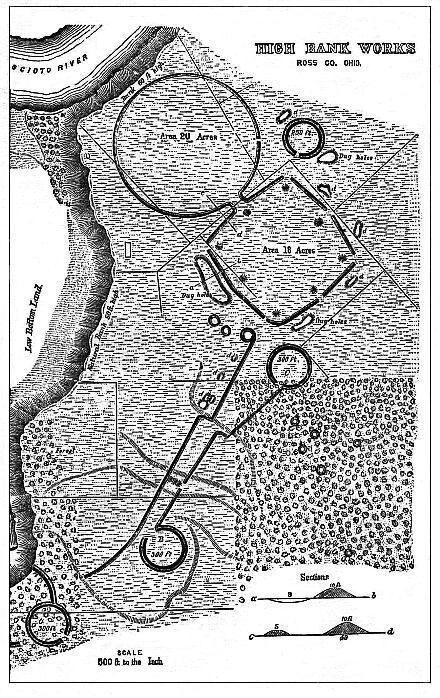
One beautiful specimen of this work is found
in this cut. It occurs on the right bank of the Scioto river,
five miles below Chillicothe. Here we notice a combination of the
octagon and the circle. The areas of each are marked. The octagon
is nine hundred and fifty feet in diameter, and nearly regular in
shape. In 1846 its walls were eleven or twelve feet high, by
about fifty feet base. It will be noticed that there is a gate at
or near each angle of the octagon except one, and in front of
that angle was a pit, from which some of the earth to form the
walls was taken. Facing each gateway a mound was placed, as if to
guard the entrance.
The circle connected with the octagon is
perfect in shape, and is ten hundred and fifty feet in diameter.
Its walls were only about half the height of the octagon. We
notice some other small circular works in connection with the
main work. In this case the parallels are not very regular, and
seem to be connected with one or more circular works. In a work
situated but a few miles from the one here portrayed, the
parallels extend in one direction nearly half a mile, only one
hundred and fifty feet apart. They terminate on the edge of a
terrace. The object of such parallels is as yet unknown. In some
cases, after extending some distance, they simply inclosed a
mound.
It is easy enough to describe this work and
give its dimensions, but who will tell us the object its builders
had in mind? The walls themselves would afford but slight
protection and if they were for defense, must have been
surmounted with palisades. Works that were undoubtedly in the
nature of fortified camps, are found in this same section, and
one of the strongest was located not more than twelve miles away;
but such defensive works differ very greatly in design from
regular structures such as we are now describing. A very eminent
scholar, Mr. Morgan, has advanced the theory that the walls were
the foundations on which communal houses, like the Pueblos of the
West, were erected.61 But this is
mere theory. All traces of such habitations (if they ever
existed) are gone, the usual debris which would be sure to
accumulate around house-sites, is wanting, and the walls
themselves seem unfit for such purpose.62
They may have been embankments surrounding
towns and cultivated fields, but little has yet been found which
can be cited as proofs of residence within the area so inclosed.
We should not be surprised, however, if such would ultimately
prove to be the case, since we now know that the Mound Builders
of Tennessee did fortify their villages by means of embankments
and ditches.63 A number of
writers think that these regular inclosures were in some way
connected with the superstitions of the people. In other words,
that they were religious in character. Mr. Squier remarks, "We
have reason to believe that the religious system of the Mound
Builders, like that of the Aztecs, exercised among them a great,
if not a controlling, influence. Their government may have been,
for aught we know, a government of the priesthood—one in
which the priestly and civil functions were jointly exercised,
and one sufficiently powerful to have secured in the Mississippi
Valley, as it did in Mexico, the erection of many of those vast
monuments, which for ages will continue to challenge the wonder
of men. There may have been certain superstitious ceremonies,
having no connection with the purpose of the mound, carried on in
inclosures especially dedicated to them."64 Another late writer to whom we have
several times referred, tells us there is no doubt but what a
"religious view" was the controlling influence in the erection of
these works, and that they express a "complicated system of
symbolism," that we see in them evidence, of a most powerful and
wonderful religious system.65
Still such assertions are easier made than proven, and until we
know somewhat the purpose for which they were used, how are we to
know whether they were sacred or not?
Casting conjectures, for the moment, aside,
let us learn what we can from the works themselves. From their
large extent they could only be reared by the expenditure of
great labor. This implies some form of government sufficiently
centralized and powerful to control the labors of large bodies of
men. Moreover, they were sufficiently advanced to have some
standard of measurement and some way of measuring angles. The
circle, it will be remembered, is a true circle, and of a
dimension requiring considerable skill to lay out. The sides of
the octagon are equal, and the alternate angles coincident.
Every year the plow sinks deeper into these
crumbling embankments, and the leveling forces of cultivation are
continually at work, and the time is not far distant when the
curious traveler will with difficulty trace the ruins of what was
once, to the Mound Builders, a place of great importance.
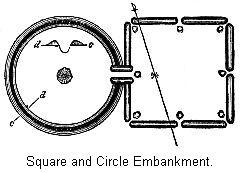 The more usual combination was that of a square and a
circle. An example is given in this cut, which is a plan on a
very small scale, of works which formerly existed in Circleville.
One peculiar feature about this work was that a double wall
formed the circle, with a ditch between the two walls. In the
next cut we notice a peculiar combination of these two figures.
The square is inclosed within the circle. Whatever we may
ultimately decide as to the larger works, it would seem as if
this could only be explained as in the nature of a religious
work. We can see no reason for constructing a defensive work, or
inclosing a village, or erecting foundations for houses of such a
shape as this. They must have been in some way connected with the
superstitions of the people.
The more usual combination was that of a square and a
circle. An example is given in this cut, which is a plan on a
very small scale, of works which formerly existed in Circleville.
One peculiar feature about this work was that a double wall
formed the circle, with a ditch between the two walls. In the
next cut we notice a peculiar combination of these two figures.
The square is inclosed within the circle. Whatever we may
ultimately decide as to the larger works, it would seem as if
this could only be explained as in the nature of a religious
work. We can see no reason for constructing a defensive work, or
inclosing a village, or erecting foundations for houses of such a
shape as this. They must have been in some way connected with the
superstitions of the people.
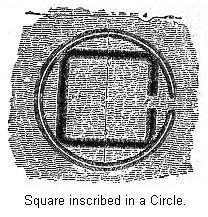
 A peculiar feature is also noticed in reference to some
of the smaller circles in this section. The cut at left
illustrates it. The circle has a ditch interior to the
embankment, and also a broad embankment of about the same height
with the outer wall, interior to the ditch, running about
half-way around the circle. A short distance from the circle was
one of those elevated squares, one hundred and twenty feet square
at the base, and nine feet high.66 It may be that this square was the
foundation on which stood a temple, in which case the circle
might have been dedicated to religious purposes also.
A peculiar feature is also noticed in reference to some
of the smaller circles in this section. The cut at left
illustrates it. The circle has a ditch interior to the
embankment, and also a broad embankment of about the same height
with the outer wall, interior to the ditch, running about
half-way around the circle. A short distance from the circle was
one of those elevated squares, one hundred and twenty feet square
at the base, and nine feet high.66 It may be that this square was the
foundation on which stood a temple, in which case the circle
might have been dedicated to religious purposes also.
The great geometrical inclosures are
especially numerous in the Scioto Valley. All the works we have
described were in the near neighborhood of Chillicothe, and works
as important as these are scattered all up and down the valley.
We must also recall how well provided this valley was with signal
mounds. All indications point to the fact that here was the
location of a numerous people, ready to defend their homes
whenever the warning fires were lit. Although Mound Builders'
works are numerous in the valley of the two Miami Rivers,
Cincinnati being the site of an extensive settlement, yet they
were not such massive structures as those in the Scioto. This
would seem to indicate that these valleys were the seats of
separate tribes.67 But this
Eastern tribe must have occupied an extensive territory, since
works of the most complicated kind are found at Newark.
All indications point to the fact that near
this latter place was a very important settlement of the Mound
Builders. Several fortified works exist a few miles up the
valley; signal-mounds are to be seen on all heights, commanding a
wide view, and the famous alligator mound is placed, as if with
the design of guarding the entrance to the valley. No verbal
description will give an idea of the works, so we refer at once
to the plan. This will give us a good idea of the works as they
were when the first white settlers gazed upon them. They have
nearly all been swept away by modern improvements, excepting the
two circular works and the octagon. Here and there fragments of
the other works can still be traced.
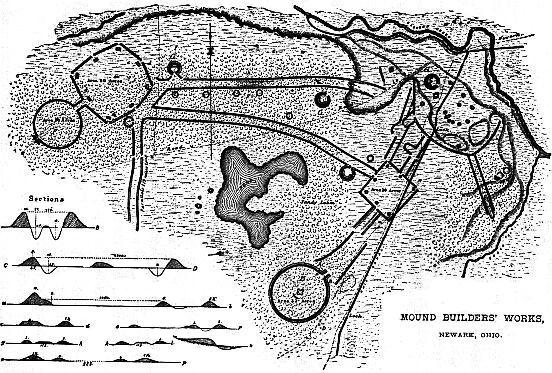
Two forks of the Licking River unite near
Newark; the bottom between these rivers comprising several square
miles, was occupied by these ancient earth-works. By reference to
the plan, we see the works consisted of mounds of various sizes,
parallel walls, generally of a low elevation, small and low
embankments, in the form of small circles and half-circles. There
are also several large works consisting of a circle and octagon
combined, one large circle, and a parallelogram. The circular
structure at 'E,' is undoubtedly one of the best preserved and
most imposing in the State. There are many inclosing larger
areas, but none more clearly defined. As this is now included in
the fair-grounds of Licking County, it is preserved from
destruction, and will remain a monument of aboriginal work long
after all traces of the others have disappeared. "At the
entrance, which is towards the east, the ends of the walls curve
outwards for a distance of a hundred feet, leaving a passage way
eighty feet wide between the deep ditches on either hand." From
this point the work, even now presents an impressive appearance.
The walls are twelve feet in perpendicular height, and about
fifty feet base. There is a ditch close around it on the inside,
seven feet deep by thirty-five feet wide. The area inclosed is
about thirty acres.
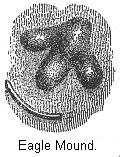 In the center is an effigy-mound, represented by this
cut. It represents a bird on the wing, and is called the Eagle
Mound. The long mound in the body of the bird has been opened,
and it was found to contain an altar, such as has been already
described. Was this a place of sacrifice, and did this wall
inclose a sacred area? Our question remains unanswered. We can
dig in the mounds, and wander over the embankments, but the
secret of the builders eludes us.
In the center is an effigy-mound, represented by this
cut. It represents a bird on the wing, and is called the Eagle
Mound. The long mound in the body of the bird has been opened,
and it was found to contain an altar, such as has been already
described. Was this a place of sacrifice, and did this wall
inclose a sacred area? Our question remains unanswered. We can
dig in the mounds, and wander over the embankments, but the
secret of the builders eludes us.
A mile to the north-west of the part of the
work just described are the Octagon and works in connection with
it. The Octagon is not quite regular, but the sides are very
nearly equal. At each angle is a gateway, interior and opposite
to which is a mound, as if to guard the opening. The cut gives a
view of the Octagon, looking in through one of these gateways. At
present, however, but a small portion is in the forest. Most of
it is under cultivation, but the work can still be easily traced,
and is one of the best preserved in the State. A portion of it,
still in the forest, presents the same appearance to-day as it
did to the first explorer. When a stranger for the first time
wanders along the embankment and ascends the mounds, he can not
fail to experience sensations akin to those of the traveler when
he comes upon the ruins of some Old World city. We wish that for
a brief space of time the curtain of the past would up-roll, and
let us view these works while yet their builders flourished
here.
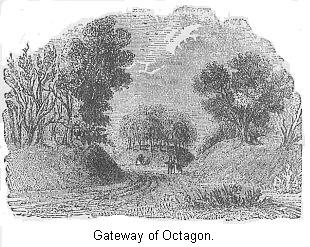
Connected with the Octagon by parallel walls
three hundred feet long and placed sixty feet apart, is the
smaller circle, "F." This is a true circle, and is upwards of
half a mile in circumference. A portion of it lying in the woods,
still retains its primitive form, but the larger part is now
under cultivation. There is no difficulty, however, in tracing
its entire length. The most interesting feature in connection
with this part of the work is immediately opposite the point of
entrance from the octagon, and is represented in our next cut. At
this point it seems as if the builders had started to make
parallel walls, but afterwards changed their design and threw
across the opening a large mound. From this mound a view of the
entire embankment could be obtained. It is called the Observatory
Mound. It has been so often dug into that it is now really in
ruins, but is still too steep to be plowed over.
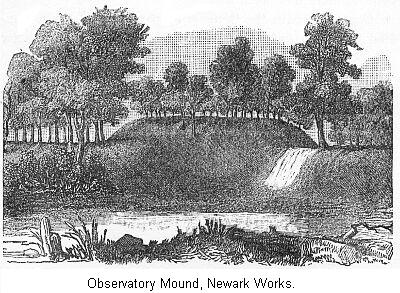
It is scarcely necessary to describe the works
further, except to state that three lines of parallel embankments
lead away from the octagon. Those extending south have been
traced for upwards of two miles, and are gradually lost in the
plain. It was the opinion of Mr. Atwater, one of the earliest
investigators, that these lines connected with other works thirty
miles away, in the vicinity of Lancaster.68 Small circles are numerous in
connection with these works. It has been suggested by several
that they mark the sites of circular dwellings. The larger ones,
indicated by the letter "G," are more pretentious. They have the
ditch and embankment, which we have already described. Many
interesting coincidents in dimensions will be perceived between
portions of this work and those described in the Scioto valley.69
Although we have devoted considerable space to
this branch of the Mound Builders' work, we must still find space
to describe the works at Marietta, which possessed some singular
features. This cut gives us a correct plan of the works as they
were when in 1788 the first settlers arrived at the mouth of the
Muskingum to lay out their town. The growth of the beautiful town
of Marietta has completely destroyed these works, except the
elevated squares, A and B, the large mound and inclosing circle
at X, with a portion of the adjoining embankments, and a small
fragment of the parallel walls forming what has been called the
"Graded Way." The elevated squares are the finest examples of
"temple" mounds remaining in the Ohio Valley. The circle and
ditch with the conical mound inclosed is also a fine example of
that class of works. From the summit of the mound an extensive
view is to be had both up and down the Ohio.
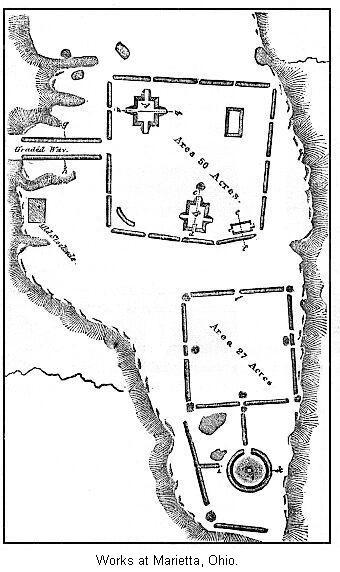
The gateways of the smaller square were
guarded by mounds, which were wanting in the larger one. We would
call especial attention to the two embankments which led from the
larger square towards the river. They were six hundred and eighty
feet long, and one hundred and fifty feet apart.70 Some have supposed these walls were
designed to furnish a covered way to the river. But as Mr. Squier
remarks, we would hardly expect the people to go to the trouble
of making such a wide avenue for this purpose, nor one with such
a regular grade. Besides, the walls did not reach the river. The
work seems to be simply a passage way, leading from one terrace
to the other, but why the builders should have made such a
massive work, we can not explain. It has been called the "Sacred
Way," and this name may possibly be applicable, but it is only
conjectural. Some twenty years ago these two massive and
beautiful embankments were still preserved, thanks to the care of
the early settlers, who planned a street to pass between them,
which was named the Via Sacra. These words still remain on
a corner signboard; but alas for sentiment! the banks, so long
revered, have been utilized for brick-working.
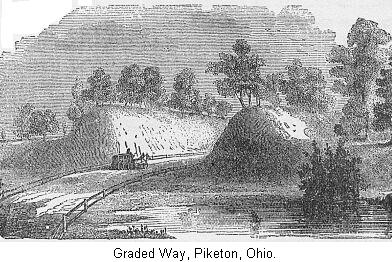
Several instances of these graded streets or
ways have been found in connection with the Mound Builders'
works. Sometimes they lead from one terrace to another, sometimes
directly to the water. One of the latter kind formerly existed
near Piqua, Ohio.71 This cut is a
view of a graded way near Piketon, Ohio. In this case, though the
difference in level between the second and third terrace is but
seventeen feet, these ancient people laid out a graded ascent
some ten hundred and eighty feet long, by two hundred and ten
feet average width. The earth was thrown out on either side,
forming embankments. From the left hand embankments, passing up
to the third terrace, there could formerly be traced a low
embankment running for fifteen hundred feet, and connected with
mounds and other walls at its extremity.
Some have supposed that formerly the river
flowed at the extremity of this graded way, and a passage way to
the water was thus furnished. Squier says, in this connection:
"It is sufficient to observe that the river now flows half a mile
to the left, and that two terraces, each twenty feet in height,
intervene between the present and the supposed ancient level of
the stream. To assent to this suggestion, would be to admit an
almost immeasurable antiquity to the structure under
consideration." The casual observer would say that it was
intended to afford an ascent from one terrace to the other. But
as the height was only seventeen feet, we can not see why it was
so necessary to have a long passage way of easy grade from one
terrace to the other. It was evidently built in connection with
the obliterated works on the third terrace. This interesting
remain is now utilized as a turnpike, and the passing traveler
but little recks he is going over one of the most ancient
causeways in the land. It may be that ceremonious processions,
with stately tread, utilized this causeway in years long since
elapsed. Speculation, always an unsafe guide to follow, is
especially so in this case, and so we leave this memento of a
vanished people as much an enigma to us as to its first
explorers.
We have described but a few of the sacred
inclosures of Ohio, but enough have been given to give us a fair
idea of all. We wish now to call attention to another class of
remains. We have seen how the works we have been describing are
lacking in defensive qualities. This becomes more marked, when we
learn there are works, beyond a doubt, defensive in character, in
which advantage is taken of all circumstances which would render
the chosen retreat more secure. In the first place, strong
natural positions were selected. They chose for their purpose
bluffy headlands leading out into the river plain. A people
surrounded by enemies, or pressed by invaders, would naturally
turn their attention to such heights as places susceptible of
defense. Accordingly, it does not surprise us to find many
heights occupied by strong and complicated works. Generally the
approaches to them were rugged and steep on all but one or two
sides, and there they are guarded by walls of earth or stone.
A fine example of a fortified hill was
discovered in Butler County, Ohio, a few miles below the town of
Hamilton. This hill is the highest one in the immediate vicinity.
By reference to the figure, we see that on all sides, except
towards the north, the approach was steep and precipitous, almost
inaccessible.
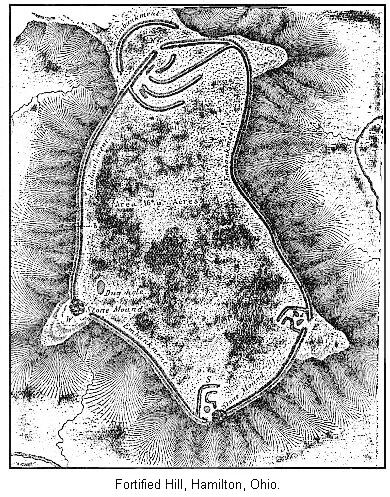
The wall is not of regular shape. It runs
around on the very brow of the hill, except in one or two places,
where it cuts across a ridge. In 1843 this wall was still about
five feet high and thirty-five feet base. The earth and stone of
which the wall is made were evidently gathered up from the
surface of the hill. In some places holes had been excavated,
probably for the double purpose of securing materials for the
wall, and providing reservoirs for water against a time of need.
There are but four openings in the wall, and each is very
carefully guarded. The complicated walls guarding the main
entrance to the north are especially noticeable. There are no
less than four inner walls besides the crescent shaped embankment
on the outside. The signal mound was about five hundred feet to
the north of the main opening. The stones on the surface of the
mound all show the action of fire.
If we were uncertain of the uses of the other
class of inclosures, which have been named Sacred Inclosures, we
have no need to hesitate as to the character of this work. Every
thing in reference to it betokens that it was a defensive work.
The valley of the Big Miami, in which it occurs, was a favorite
resort of the Mound Builders. On the opposite side of the river,
to the south, was a square and an ellipse combined, and several
other large works were ranged along the river in the course of a
few miles. We need scarcely doubt that this was a citadel in
times of need, and that when warning columns of smoke or flaming
fires showed the approach of an enemy, the old and the sick, the
women and the children, fled hither for protection, while the
warriors went forth to battle for their homes.
We will call attention to but one more of
these fortified hills, but this is on a magnificent scale. It is
known as Fort Ancient, and is situated on the Little Miami River,
about forty miles east of Cincinnati. It was not only a fort, but
was also a fortified village site, and has some features about it
which are regarded as of a religious nature. The hill on which it
stands is in most places very steep towards the river. A ravine
starts from near the upper end on the eastern side, gradually
deepening towards the south, and finally turns abruptly towards
the west to the river. By this means nearly the whole work
occupies the summit of a detached hill, having in most places
very steep sides. To this naturally strong position
fortifications were added, consisting of an embankment of earth
of unusual height, which follows close around the very brow of
the hill. This embankment is still in a fine state of
preservation, but is now annually exposed to cultivation and the
inroads of cattle, so that it will not be long before it will be
greatly changed if no effort be made to preserve it.
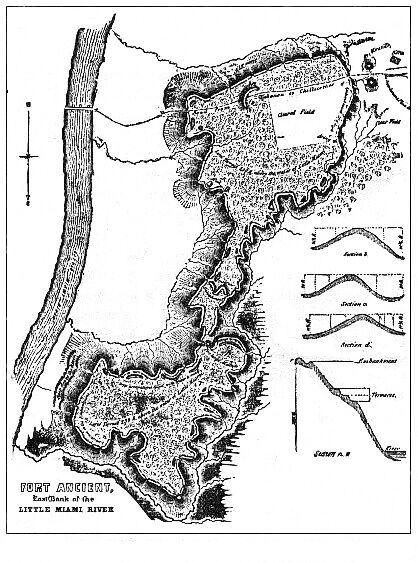
This wall is, of course, the highest in just
those places where the sides of the hill are less steep than
usual. In some places it still has a height of twenty feet. We
notice the wall has numerous breaks in it. Some of these are
where it crosses the ravines, leading down the sides of the hill.
In a few cases the embankment may still be traced to within a few
feet of a rivulet. Considerable discussion has ensued as to the
origin and use of these numerous gateways. Mr. Squier thinks that
these openings were occupied by timber work in the nature of
blockhouses which have long since decayed. Others, however, think
that the wall was originally entire except in a few instances,
and that the breaks now apparent were formed by natural causes,
such as water gathering in pools, and musk-rats burrowing through
the walls, and we are told that such an opening was seen forming
in the year 1847.72 No regular
ditch exists inside the wall, the material apparently being
obtained from numerous dug holes.
It will be seen that the works could be
naturally divided into two parts, connected by the isthmus. More
than one observer has pointed out the resemblance in general
outline of this work to a map of North and South America, but of
course the resemblance, if any, is entirely accidental. Mr. Peet
has called attention to the resemblance which the walls of the
lower inclosure bear to two serpents, their heads being the
mounds, which are separated from the body by the opening which
resembles a ring around the neck. Their bodies are the walls,
which, as they bend in and out, and rise and fall, much
resembles, he thinks, two massive green serpents rolling along
the summit of this high hill. If any such resemblance occurs, we
think it purely accidental. In relation to the wall across the
isthmus, it has been thought to have been the means of defending
one part of the work should an enemy gain entrance to the other.
It has also been supposed that at first the fort was only built
to the cross wall on the isthmus, and afterwards the rest of the
inclosure was added to the work.
The total length of the embankment is about
five miles, the area enclosed about one hundred acres. For most
of this distance the grading of the walls resembles the heavy
grading of a railroad track. Only one who has personally examined
the walls can realize the amount of labor they represent for a
people destitute of metallic tools, beasts of burden, and other
facilities to construct it.
Now, what was the object of this work? We
think it was not simply a fort, but rather a fortified village.
That it must have required the work of a numerous body of people,
is undoubted, and if they lived elsewhere, where are the works
denoting such a fact? We would further suggest that, if this was
the seat of a tribe, each of the two divisions might have been
the location of a phratry of the tribe, by a phratry, meaning the
subdivision of a tribe. We would call especial attention to the
two mounds seen just outside of the walls at the upper end. From
these mounds two low parallel walls extended in a north-easterly
direction some thirteen hundred and fifty feet, their distant
ends joining around a small mound. As this mound was not well
situated for signal purposes, inasmuch as it did not command a
very extensive view, and as the embankments would afford very
little protection, unless provided with palisades, it seems as if
the most satisfactory explanation we have is that it was in the
nature of a religious work.
Mr. Hosea thinks he has found satisfactory
evidence that between these walls there was a paved street, as he
discovered in one place, about two feet below the present
surface, a pavement of flat stones.73 From this, as a hint, he eloquently
says: "Imagination was not slow to conjure up the scene which was
once doubtless familiar to the dwellers at Fort Ancient. A train
of worshipers, led by priests clad in their sacred robes, and
bearing aloft the holy utensils, pass in the early morning, ere
yet the mists have risen in the valley below, along the gently
swelling ridge on which the ancient roadway lies. They near the
mound, and a solemn stillness succeeds their chanting songs; the
priests ascend the hill of sacrifice and prepare the sacred fire.
Now the first beams of the rising sun shoot up athwart the ruddy
sky, gilding the topmost boughs of the trees. The holy flame is
kindled, a curling wreath of smoke arises to greet the coming
god; the tremulous bush which was upon all nature breaks into
vocal joy, and songs of gladness bursts from the throats of the
waiting multitude as the glorious luminary arises in majesty and
beams upon his adoring people. A promise of renewed life and
happiness. Vain promise, since even his rays can not penetrate
the utter darkness which for ages has settled over this people."
Thus imagination suggests, and enthusiasm paints a scene, but,
from positive knowledge, we can neither affirm nor deny its
truth.
Most of the works of the Mound Builders are
noticeable for their solidity and massiveness. We see this
illustrated in the great walls of Fort Ancient. Some of our
scholars think this is a distinguishing feature of the Mound
Builders' work.74 It seems to us
that it is difficult to make this a distinguishing feature, as we
have no means of knowing how much "massiveness" is required in a
work to entitle it to be considered a work of the Mound Builders.
Should this distinction be established, however, we have to
notice that while in the western part of the State of Ohio the
Mound Builders' inclosures are more often of the defensive sort,
the type changes to the eastward, where, as in the Scioto Valley,
we find the so-called sacred inclosures in larger numbers. In the
State of Ohio, then, there were at least two well defined types
of works by the Mound Builders. But if we split the Mound
Builders up into tribes, where shall we draw the line between
them and our later Indians?
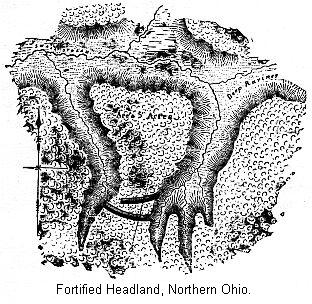
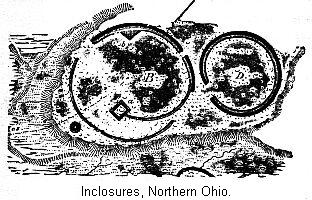
Scattered through Ohio, but especially
abundant in the northern part of the State, is a class of works
which has excited considerable comment. This cut illustrates a
work of this kind. It was located near where Cleveland now
stands. The defense consists mainly in the location. The wall
seems to have been rather of a secondary affair. The hill was too
steep to admit approach to it except from the rear, where the
double wall was placed. With both of these works a ditch was dug
outside the wall. These works did not always consist simply of
fortified headlands. This cut is of a portion of the works
formerly existing near Norwalk, Ohio. The circular work, D, is
shaped much like the sacred inclosures, though not on so large a
scale. In the larger work, at B, we notice a truncated mound. The
ditch is on the outside of the circles. This cut is of a work
formerly on the banks of the Black River. Here we have a square
inclosure, defended by two embankments and a ditch.

This class of works was formerly common not
only in Ohio and Western New York, but they were also to be
observed in other sections of the country. They existed alike in
the valley of the two Miami Rivers, and in that of the Scioto.
They were also found throughout the South. Even Wisconsin, the
home of the effigy Mound Builders, is not destitute of this class
of remains. The peculiar interest attaching to them arises from
the fact that in some places, at least, we have good reason to
assign their construction to Indian tribes. Those of Western New
York were very thoroughly studied by Mr. Squier. When he
commenced his investigations, he was under the impression that he
was dealing with the remains of a people very similar, at least,
to those who built the massive works in the Ohio Valley and
elsewhere, but he was led to the conviction that they were the
works of the Iroquois Indians, and as further proof that such was
the case, we are told that since the palisades that once inclosed
places known to be villages of the Iroquois have disappeared,
there is no difference to be observed between the appearance of
the ruins of such a village site and any of the earthworks in
Western New York. But we have just stated that the remains last
mentioned are identical with those found in Northern Ohio, and
indeed over a wide extent of country. The conclusion seems to be,
then, that one large class of works in many points resembling
Mound Builders' works, found widely distributed throughout the
Mississippi Valley, were really the works of Indians.75 But we are approaching a subject we do
not wish to discuss just yet. We simply point out that not all
the remains of prehistoric people in the Mississippi Valley are
referable to the Mound Builders.
We have tried to point out the more important
works that are ascribed to them. It must of necessity occur in a
work of this nature that the review should be very brief, yet we
have touched on the different classes of their works. But before
leaving this part of our field we must mention some anomalous
works, and refer to others which, if they can be relied on as
works of the same people, certainly imply a great advance on
their part.
Our next cut is named by Mr. Pidgeon the
"Sacrificial Pentagon." Writing in 1850, he states, "This
remarkable group . . . has probably elicited more numerous
conjectures as to its original use than any other earth-work yet
discovered in the valley of the Mississippi. . . . It is situated
on the west highlands of the Kickapoo River, in Wisconsin."76 Mr. Pidgeon claims to have
discovered two of these pentagons. We are not aware that any one
else has verified these discoveries, and it is difficult to
decide what value to give to his writings. He claims to have made
extensive researches around the head-waters of the Mississippi as
early as 1840, and there to have met an aged Indian—the
last of his tribe—who gave him many traditions as to the
mounds in that locality. Most of our scholars think his writings
of no account, whatever, and yet Mr. Conant says, "He seems to
have been a thoroughly conscientious and careful observer,
faithfully noting what he saw and beard."77

We will briefly describe a few of the
earth-works he mentions, notice their singular form, and give an
outline of the traditions in regard to them, leaving the reader
to draw his own conclusions. Of this work the outer circle is
said to have been twelve hundred feet in circumference, the walls
being from three to five feet in height; width on the ground from
twelve to sixteen feet. The walls of the pentagon were from four
to six feet high. The inner circle was of very slight elevation.
The central mound was thirty-six feet in diameter. This singular
arrangement of circle, pentagon, and mounds, is traditionally
represented to have been a sacred national altar—the most
holy one known to tradition—and no foot, save that of a
priest, might pass within the sacred walls of the pentagon after
its completion. The sacrifice offered on this altar was that of
human life. Twice each year the offering was made.78

The work represented in the figure at left is
stated to have been in the near neighborhood of the former, and
to have been intimately connected with it. Mr. Pidgeon claims to
have found five of these circles and two pentagons. So far as we
know, he is the only authority for their occurrence, no one else
having been so fortunate as to have found them. This is surely a
singular work, and we can not fail to recognize in it a
representation of the sun and the moon. In excavating in the
central mound, we are assured that small pieces Of mica were
found abundantly mixed with the soil. "Had the surface-soil been
removed with care, and the stratum beneath been washed by a few
heavy showers of rain, so thoroughly studded was it with small
particles of mica, that under the sun's rays it certainly would
have presented no unapt symbolic representation of that
luminary."79

Our next figure is another singular
arrangement of crescent-shaped works and mounds. Lapham says that
crescent-shaped works are found in Wisconsin. Pidgeon says that
crescent works are found in Illinois, but works arranged as shown
in this wood-cut he found in but four places in Wisconsin. Could
we verify this author's statements, this illustration and the
preceding one would be very good evidence of the prevalence of
sun-worship among the effigy Mound Builders of Wisconsin. This
would be nothing singular, since the Indian race almost
universally reverenced the sun.80
The figure below represents a group of works
which, we are told, were of a class formerly abundant in Missouri
and Iowa. The embankments are stated to be of varying heights,
but all of the same length. They do not quite meet, but a mound
defends the opening. Sometimes a square is so represented, and
sometimes but two walls.
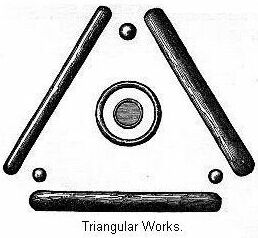
A singular statement is made in reference to a
nice proportion said to be observed between the heights of the
embankments and walls. In this case, for instance, the heights of
the embankments are, three, four, and five feet; the sum of
these, twelve feet, was the exact height of the central mound.
Furthermore, the square of the sum of the heights of three
embankments gives us one hundred and forty-four feet, which is
the length of the embankments. We are gravely assured that this
same nice proportion is always observed in works of this kind.
The embankments being always of equal length, but of varying
heights, still the sum of these heights, whether three or four
sides, being always equal to the height of the central mound.81 We do not know of any specimen of
this class of works now existing. If this early explorer's
account be reliable, then we have in works of this class very
good evidence that some of their inclosures were in the nature of
sacred inclosures. The trouble is to verify Mr. Pidgeon's
account. There is a good deal that is strange and marvelous in
reference to the Mound Builders, and we must use judgment as to
what is told us, unless we are sure there is no mistake, or
unless the reports are vouched for by many observers.
We wish to call attention to some singular
works in Missouri, which would imply that the Mound Builders were
possessed of no little engineering skill. We have every
indication that near New Madrid was a very extensive settlement.
The works consist of inclosures, large and small mounds in great
numbers, and countless residence sites. One of fifty acres was
noticed, which had evidently been inclosed by earthen walls. In
some places in the forest, where this wall had been preserved,
its height was found to be from three to five feet, and its base
width fifteen feet.82 But the
suggestive features about these works are noticed along the edge
of the swamp near which they stood. This swamp in 1811 was a
lake, with a clear, sandy bottom. It is not at all doubted but
that it was at one time the bed of the Mississippi River, and
probably this town stood on its banks. The river is now some
eighteen miles away. It must suddenly have changed its course,
leaving behind it a lake, which, in course of time, became a
swamp.
But along the shores of this ancient lake, in
front of the inclosure, small tongues of land have been carried
out into the water, from fifteen to thirty feet in length, by
ten, or fifteen in width, with open spaces between, which, small
as they are, forcibly remind one of the wharfs of a seaport town.
The cypress trees grew very thickly in all the little bays thus
formed, and the irregular, yet methodical, outlines of the
forest, winding in and out close to the shore of these tongues of
land, is so marked as to remove all doubt as to their artificial
origin.83 The suggestion is made
in view of these wharfs, that the Mound Builders must have had
some sort of boats to navigate the waters of the lake.
And the singular part is, that right in this
neighborhood are many evidences of a system of canals. A glance
at the map will show that the portion of Missouri around New
Madrid, and to the south of it, is dotted with swampy lakes and
sluggish bayous. The evidence is to the effect that the ancient
inhabitants connected these bayous and lakes with artificial
canals, so as to form quite an extended system of inland
water-ways. Right east of the town of Gayoso, we are told that a
canal had been dug that now connects the Mississippi with a lake
called Big Lake. A bayou running into this lake was joined by a
canal with Cushion Lake.
From this last lake, by means of bayous and
lakes, a clear course could be pursued for some miles north,
where finally another canal was cut to join with the Mississippi
a few miles below New Madrid. The entire length of this water way
was some seventy miles, but we are not told how much of it was
artificial, neither are the dimensions given. Prof. Swallow
speaks of a canal "fifty feet wide, and twelve feet, deep."
Whether this was one of this series or not, we do not know.84 This is indeed a singular piece
of work. It would be more satisfactory if we had more definite
information in regard to the same.
With our present knowledge of the state of
society among the Mound Builders, as made evident by the remains
of their implements and ornaments, we are not justified in
believing this part of a system of internal navigation. We have
already seen that further south they sometimes surrounded their
village sites with a wide and deep moat or ditch, as was observed
around the inclosure containing the great mound on the Etowah. We
are inclined to believe that a more careful survey would greatly
modify the accounts we have of these canals, if it did not, in
fact, show that they were the works of nature. According to a
writer in the American Antiquarian,85 the whole lower part of the
Mississippi Valley was abundantly supplied with canals,
irrigating ditches, and evidences of a high intelligence. He
speaks of observing the presence of an extensive canal a little
north of the section we have described. He asserts they were dug
to convey the surplus waters of the Mississippi in times of flood
to the White and St. Francis Rivers, thus preventing disastrous
overflows. It is needless to caution the reader against such
conclusions. Our information in regard to those canals is far too
limited to support the views advanced.
This finishes our examination of the works of
the Mound Builders. Except in the case of the more massive works,
they have become obliterated, but here and there are left traces
of the former presence of these now vanished people. The
antiquary muses over the remains of their inclosures, their
fortified places, their effigies and mounds. By the combined
efforts of scholars in many departments, we may yet hope that the
darkness now enshrouding this race may be dissipated, but at
present our positive knowledge is very limited indeed. It is as
if we were asked to reconstruct a picture which had faded in the
lapse of time so that only traces here and there are visible.
Here, perhaps, a hand is seen; there a piece of foliage; in one
place something we think representing water, in another a patch
of sky, or a mountain peak. Until a key is found which shall show
us how to connect these scattered parts, our efforts are useless,
since many pictures could be formed, but we have no surety we are
right. So we may form mental conceptions of the Mound Builders,
but they are almost as varied as the individual explorers.
Science may yet discover the key which will enable us to form a
clear mental conception of the race which flourished here many
years ago, and left their crumbling memorials to excite the
curiosity of a later people.
We must now turn our attention to another
branch of inquiry and learn what we can of the culture of the
Mound Builders. This is to be determined by an investigation of
the remains of their implements, weapons, and ornaments. When we
know the skill with which they manufactured these articles, and
gain an insight into some of their probable customs, we shall
know where to place them in the scale of civilization. What we
have learned of their works has already convinced us that we are
dealing with a people considerably above the scale of Savagery.
The nice proportion between the parts, the exact circles and
coincident angles show considerable advance in mechanical skill.
The character of the works indicates that the people had
permanent places of abode, and were not subject to the
vicissitudes of a hunter's state of life for subsistence. This
implies that we are dealing with a people living in village
communities, practising agriculture and many other arts, and
therefore entitled to rank in the middle status of Barbarism
corresponding to the Neolithic inhabitants of Europe.86 We will now see how far this
conclusion is sustained by an examination of the remains of the
handiwork of the people.
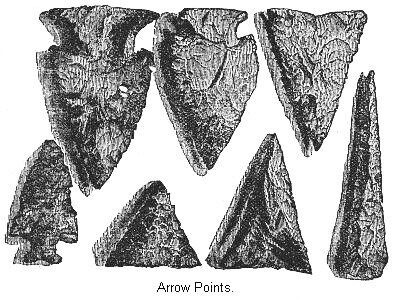
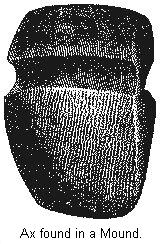
Implements of stone are of course abundant.
But men, when in the culture of the Stone Age, having a common
material to work upon, and under the pressure of common needs,
have everywhere provided similar forms. For this reason it is
hard to find distinctive points of difference between implements
of stone of Mound Builders' work and a series of similar
implements the work of Indians. We are assured, however, that
when examining a series of each, those of the Mound Builders
display a superior finish.87 The
preceding wood-cut represents a collection of arrow-points found
in the mounds, but they are not particularly so distinguishable
from specimens found on the surface. Great numbers of
arrow-points are occasionally found on altars. Here we have a
view of one of the stone axes fashioned by the hands that heaped
the mounds. It is certainly a very fine specimen.
The Mound Builders must have had all the
varieties of stone implements common to people in their stage of
culture, such as axes, fleshers, and chisels. They also must have
possessed mortars and pestles for grinding corn, and some
implements did duty as hoes and spades. We represent in a group a
collection of weapons and implements from the mounds and stone
graves of Tennessee. All these articles are finely finished. One
of the axes has a hole bored through it. One of them is further
provided with a stone handle, and is characterized as being the
"most beautiful and perfect stone implement ever exhumed from the
aboriginal remains within the limits of the United States."

People in the culture of the Stone Age make
but very rare use of metal, as metals are to them simply
varieties of stone, much less useful for their purpose than the
different kinds of flints, except for ornaments. From the altar
mounds, near Cincinnati, were taken ornaments of silver, copper,
iron and traces of gold, all of which had been worked into their
present shape by simply hammering. The iron, it should be
remarked, was meteoric iron, which can be hammered as easily as
native copper. We have already remarked that about the only
native iron is obtained from such sources. Copper was utilized
for a great variety of purposes.
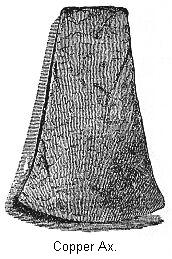
We give a cut of a copper ax found in one of
the Ohio mounds. Copper axes have lately been found quite
frequently in mounds near Davenport, Iowa, and in most cases
before being deposited in the mounds, they had been wrapped in
cloth. Copper ornaments are a more common find. Bracelets, beads,
and ear ornaments are numerous. Our next cut represents some very
fine bracelets found in a mound near Chillicothe, Ohio, Copper
tools and weapons have been found quite frequently on the
surface, but we are not sure in this case whether they are not
the work of recent Indians. The early explorers noticed the
presence of copper ornaments among the Indians. "When Henry
Hudson discovered, in 1609, the magnificent river that bears his
name, he noticed among the Indians of that region pipes and
ornaments of copper." The account says: "They had red copper
tobacco pipes, and other things of copper they did wear about
their necks."88 De Soto also
noticed among the Southern Indians axes of copper. Other accounts
could be quoted showing that the Indians were well acquainted
with copper.89 The fact is, in
this matter also, it is impossible to draw a dividing line
between relics of the Mound Building tribes and the Indians.
However, the Mound Builders were certainly acquainted with
copper, but to their minds it was only a singular stone, one that
they could hammer, into a desired shape.

Where did they obtain their copper? We are all
aware that in this country great supplies of pure copper exist
near the southern shore of Lake Superior, and there is a
peculiarity about the copper found there, that is, the presence
of small pieces of silver with the copper. This is a very
singular mixture, and we are not aware of its occurrence
elsewhere. It would trouble the best chemists to explain it. From
this fact we are enabled to identify articles of copper derived
from that source, and to that region we can trace the copper from
which are formed most of the copper implements and ornaments
found in this country. It is also noticeable that the nearer we
get to this region the more numerous are the finds of articles of
copper. More are reported from Wisconsin than the rest of the
United States put together.
This leads us to a very interesting subject.
In 1848 Mr. S. O. Knapp, agent of the Minnesota Mining Company on
the northern peninsula of Michigan, discovered that the modern
miners were but following in the footsteps of some ancient people
who had mined for copper there some time now far past. The
general conclusion is that these old miners were Mound Builders,
but here the evidence of their presence is not found in the
existence of mounds and earthworks, but of pits and excavations,
which, by the slow accumulation of years, had become filled to
near the surface with débris of various kinds. Many
had noticed these little pits and depressions without suspecting
they had aught to do with the presence of man. The hollows made
by large trees, overturned by the wind, frequently left as well
marked depressions as these excavations.
We have abundant proof that these old miners
were practical workmen. They evidently did not neglect the most
trifling indication of metals. They made thorough research and
discovered the principal lodes. Our present day miners have long
since learned to regard the presence of these ancient pits as
excellent guides in this matter. With modern appliances they
penetrate far beyond the power of the old workmen. At the
Waterbury mine there is in the face of the vertical bluff an
artificial opening, which is twenty-five feet wide, fifteen feet
high, and twelve feet deep. The materials thrown out in digging
had accumulated in front, and on this forest trees common to that
region were growing of full size. Some of the blocks of stone
which were removed from this recess would probably weigh two or
three tons, and must have required the use of levers to move
them. Beneath the surface rubbish was discovered the remains of a
cedar trough, by which the water from the mines was conducted
away. Wooden bowls were found, which were probably used to dip
the water from the mine into this trough.
Near the bottom of the pit, shovels, made of
cedar, were found, shaped much like a canoe paddle, but showing
by their wear that they were used as shovels. Although they
appeared solid while in water, yet, on drying, they shrunk up,
and were with difficulty preserved. A birch tree, two feet in
diameter, was observed growing directly over one of these
shovels. No marks of metallic tools were observed anywhere about
this large pit.

In this case they constructed a sort of a
cave, but in many cases they mined open to the air, that is, they
simply dug trenches or pits. A row of these ancient pits, now
slight depressions, indicate a vein. What they seem to have
especially sought after was lumps of copper that they could
easily manage and fashion by hammering. They had not discovered
the art of melting. When they found an unusually large piece,
they broke off what they could by vigorous hammering. In one case
they found a mass weighing about six tons of pure copper. They
made an attempt to master this piece. By means of wedges they had
got it upon a cob-work of round logs or skids, six or eight
inches in diameter, but the mass was finally abandoned for some
unknown reason after breaking off such pieces as they could until
the upper surface was smooth. This mass rested on the framework
of logs while the years came and went, until, after the lapse of
unknown time, the white men once more opened the old mine.
On the rubbish in front of this mine was
standing the stump of a pine tree ten feet in circumference.
These ancient mines are found not only on the main-land, but on
the islands off the coast as well. The only helps they seem to
have employed was fire, traces of which are found everywhere, and
stone mauls and axes. The mauls consist of oblong water-worn
bowlders of hard tough rock, nature having done every thing in
fashioning them except to form the groove, which was chiseled out
around the middle. Some copper implements were also found.
Col. Whittlesey, from whose writings we have
drawn the foregoing, concludes that these mines were worked by
the Mound Builders. As he finds no traces of graves or houses, or
other evidence of a protracted stay, he thinks they were worked
only through the Summer season of the year by bands of workmen
from the south.
As to what caused the abandonment of the works
we do not know. It might have been an impulse of their race
hurrying them on to some distant migration; or, more probably,
pressed by foes from without, they were compelled to abandon
their ancient homes. Whatever the cause was, nature resumed her
sway. Forest trees crept up to and grew around the mouths of the
deserted mines. Col. Whittlesey concludes from the group of trees
growing on the top of the rubbish heap that at least five hundred
years passed away before the white man came from the south to
resume the work of his ancient predecessor.90
It is not, however, proven that the Mound
Builders were the sole workers of these ancient mines. It is
known that the Indians mined for flint. Some of the excavations
for this purpose, in what is known as Flint Ridge, in Muskingum
County, Ohio, are as marked as the traces of ancient mining in
Michigan. Similar appearances are recorded in Missouri. As copper
was in demand among the Indians, and as it is probable that they
obtained much of it from the North, they may have continued to
work the ancient copper mines until comparatively recent times.
Mr. Lapham believes that the progenitors of the Indian tribes
found dwelling in the regions near these mines, carried on mining
operations there. Dr. Rau thinks it probable that small bands of
various Northern tribes made periodical excursions to the
locality, returning to their homes when they had supplied
themselves with sufficient quantities of the much-desired metal.
The fact that many of the modern Indian tribes knew nothing about
these mines is not of much weight, when we reflect how easily a
barbarian people forget events, even those of a striking
nature.
We are apt to judge the culture of a people by
the skill they display in works of arts. The article on which the
Mound Builder lavished most of his skill was the pipe. This would
show that with them, as with the modern Indians, the use of the
pipe was largely interwoven with their civil and religious
observances. In making war and in concluding peace, it probably
played a very important part. "To know the whole history of
tobacco, of the custom of smoking, and of the origin of the pipe,
would be to solve many of the most interesting problems of
American ethnology."91
The general decoration consisted in carving
the bowl of the pipe into the shape of some animal or bird. In
some instances we have carved representations of the human head.
Such as these are of particular interest and value, as they are
probably faithful representations of the features of the Mound
Builders. This is a fine specimen found in one of the altar
mounds in Ohio. The method of wearing the hair is worthy of
notice. The holes placed in a row encircling the forehead and
coming down as low as the ears, were once filled with pearls. In
some they still remained when found, though they had been burned
in the fire. The lines upon the face obviously imitate the custom
of tattooing the countenance.
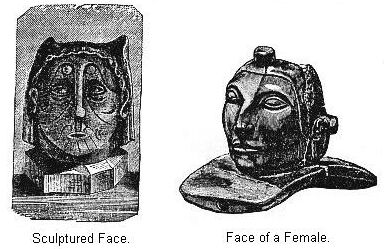
Scholars have called attention to the fact
that Humboldt discovered in Mexico a small statue which he
supposed represented an Aztec priestess. This statue had
sculptured upon its forehead a row of pearls, worn in the same
manner as is represented in this pipe. This is another pipe of
great interest, and is supposed to represent the head of a woman.
The countenance is expressive, the eyes prominent, and the lips
full and rounded. We must notice again the headdress. While the
faces are of Indian type, the method of wearing the hair is
different from that of the typical Indian of the North.

The animal forms into which the pipe-bowls are
carved, are also full of interest. This is not so much on account
of animal forms themselves as the insight we gain as to the
artistic skill of the people who fashioned the pipes, and in
various ways learn of bits of customs and manners peculiar to
them. Here we have figured a pipe, the bowl of which is carved to
represent a beaver. No one need hesitate as to the animal which
the carver had in mind. It is represented in a characteristic
attitude, and has the broad, flat tail of its species. It must
have required no little skill and patient labor to work a rough
stone into this finished pipe, especially when we remember that
the maker had no edged tools with which to work.
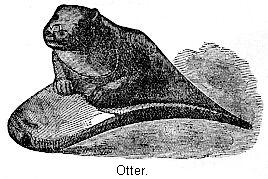
We can not always determine the animal which
the artist had in mind. In this illustration we have figured such
a pipe. Considerable discussion has arisen as to the animal
represented. Some cases of this nature have been thought to show
either migration from a distant country on the part of the maker
or else an extended system of trade.
Squier and Davis, who first figured it,
supposed it to represent a manatee, or sea-cow. This animal is
essentially a tropical species, the only known place where it was
found in the United States being Florida. From the presence of
this carved specimen, found a thousand miles to the north, some
interesting queries, as the origin of the mound-building tribes,
and the state of life among them, were raised. It is almost
certain, however, that the animal intended to be represented was
the otter.92

The most general form of sculpture was that of
birds, and we find specimens of almost all the common varieties.
In this group we recognize the tufted heron striking a fish; the
eagle, or hawk, tearing a smaller bird; the swallow, apparently
just ready to fly; and in the last figure, one that has given
rise to a good deal of discussion. Some think from the
circumstance of its having a very large bill, toes pointing
behind as well as before, that it represents a toucan, which, if
true, would make it a most interesting specimen. But cautious
scholars conclude that the "figure is not of sufficient
distinctness to identify the original that was before the
artist's mind." And therefore it is not wise to make this
specimen the subject of a far-reaching speculation.93
It may be of interest to inquire whether the
Indians made pipes as tastefully ornamented as those we have
described. We should notice that all the pipes here described are
from one very limited locality in Ohio, and that is the valley of
the Scioto, the same section of country where were found the
great inclosures of a mathematical shape. We have no reason for
supposing that the Mound Builders generally throughout the
Mississippi Valley had this artistic skill. We have seen nowhere
any thing to show a superiority for them in this respect.
Whatever conclusion can be drawn from those pipes, applies only
to the tribe in the Scioto Valley. It is believed they do
constitute a peculiar class by themselves. As works of art, there
are but few aboriginal relics of North American origin their
equal.94
We would also refer to the fact that most of
these specimens were obtained from one altar-mound.95 We do not know what ceremonies were
performed around this altar, but if it were a place of burial or
cremation, they might have been the obsequies of some
distinguished maker of pipes. That such a person would be the
recipient of honor, is not singular, for "the manufacture of
stone pipes, necessarily a painful and tedious labor, may have
formed a branch of aboriginal industry, and the skillful pipe
carver probably occupied among the former Indians a rank equal to
that of the experienced sculptor in our times." Among the Ojibway
Indians, we are told, are persons who possess peculiar skill in
the carving of pipes, and make it their profession, or at least
the means of gaining, in part, their livelihood. One "inlaid his
pipes very tastefully with figures of stars, and flowers of black
and white stones. But his work proceeded very slowly, and he sold
his pipes at high prices."96 So
we see how cautious we must be about drawing inferences from this
peculiar class of pipes found in one limited locality.
The knowledge of how to manufacture pottery is
justly regarded as a turning point in the advance of primitive
man along the weary road that brings him at last to civilization.
At this point he ceases to be a savage, and enters the confines
of Barbarism.97 The skill shown
in using this knowledge is one of the many things we have to take
into consideration in determining the rank of a people in the
scale of enlightenment. The Mound Builders were evidently quite
well along in the potter's art; and as they have left behind them
many examples of their work, we must try and acquaint ourselves
with some of the more important varieties.
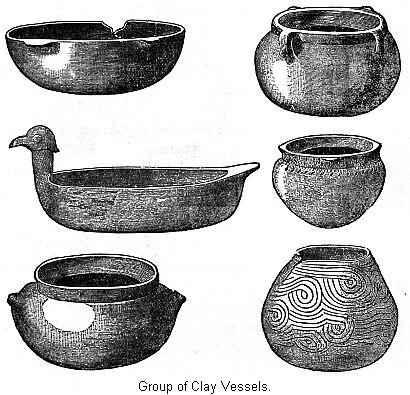
This illustration is of a group of clay
vessels of the bowl pattern, found in mounds in different parts
of the Mississippi Valley. In one of these we see a good example
of the style of ornamentation by means of incised lines. In the
duck-headed vessel we have a representation of a class of vessels
common in Missouri and Tennessee. Not unfrequently one or both of
the handles of vessels of this class is in the form of a human
head instead of that of an animal. Our next illustrations
represent a group of such specimens. Judging from the skill with
which they imitated animals, it is not unreasonable to believe
that in these faces we have rude likenesses of the people who
made them.

The two bottle-shaped vessels here figured,
are from mounds in Louisiana. As will be noticed, the
ornamentation is quite artistic. The ware is of a good quality,
and they are good examples of the Mound Builders' art. The form
with the long neck is perhaps a water-cooler. When filled with
water, and allowed to stand, some of the water passes through the
pores, and evaporating, keeps the surface of the vessel cool.
They also made some vessels of large size to
serve for cooking purposes. On some of the larger vessels the
imprint of woven weeds and willows of a basket on the outer
surface leads to the belief that such vessels were formed or
moulded within baskets. Many large pots and urns, however, were
made without this aid. Some large urns were used for burial
purposes. In a Michigan mound an urn about three feet in height
had been so used. It was standing upright, and into it the whole
skeleton of a man had been compressed, and a closely-fitting lid
covered the top.98 Very large,
shallow vessels were used to manufacture salt—that is, they
were filled from some salt-spring, and then the water was
evaporated, leaving the salt. In localities near salt-springs,
thick fragments of rude earthenware have been found that must
have come from vessels as large as barrels.
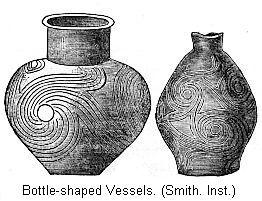

In the next group we have representations of a
singular class of vessels. In some cases the mouth and neck of
the vessel is shaped in imitation of animals. In the smallest one
we recognize the head of a man, with an opening in the back of
the head. Many vessels of this form are known, and a great many
different animal heads are represented. The fish-shaped vessel is
a curious one. The one figured evidently represents a sun-fish.
The long vase or jug is in the shape of a child's leg, with an
opening in the heel.

Some very beautiful vessels of the character
of those we have figured, have been found in Missouri. One
enthusiastic explorer says, "Perhaps we have very few modern
artists who could equal those ancient pottery makers in taste,
skill, curious design, and wonderful imitation of nature. Birds,
beasts, fishes, even the shells on the river shore, have an exact
counterpart in their domestic utensils." "While digging in one of
these pottery mounds in Missouri, we unearthed a large tortoise.
We thought it was alive, and seizing it, to cast it into the
woods for its liberty, we were suddenly surprised to find our
tortoise was an earthen vessel in that shape. In the same mound
we uncovered a huge shell—the single valve of a unio.
Closer inspection revealed that it was a perfect earthen vessel.
Following these came a perfect fish, exhibiting, to our
astonishment, the scales, fins, and peculiarities of that species
of fish in detail."99
We must leave this interesting part of our
subject. An entire volume would scarcely do justice to it, but
for the sake of comparison, we must inquire as to the state of
this art among the Indian tribes. It seems that before the
arrival of the whites, the Indian tribes throughout North
America, with few exceptions, were apt potters. The whites,
however, soon supplied them with superior utensils of metal, so,
that the majority of the Eastern tribes soon lost the knowledge
of the art. It lingered longer among the tribes of the South, and
of the interior, and even to this day the Pueblo tribes of New
Mexico and Arizona make an excellent article of pottery. Early
travelers wrote in high terms of the skill of the Southern
Indians in this matter. Du-Pratz thought so highly of the work of
the Natchez Indians that he had them make him an entire dinner
set.
Catlin, speaking of the Mandan Indians, says
the women of that tribe made great quantities of dishes and
bowls, modeled after many forms. He says they are so strong and
serviceable that they cook food in them by hanging them over the
fire, as we would an iron pot. "I have seen specimens," he
continues, "which have been dug up in Indian mounds and tombs in
the Southern and Middle States, placed in our Eastern museums,
and looked upon as a great wonder, when here this novelty is at
once done away with, and the whole mystery: where women can be
seen handling and using them by hundreds, and they can be seen
every day in the summer, also, moulding into many fanciful forms,
and passing them through the kilns, where they are hardened."
Dr. Rau, speaking of the artistic skill of the
Indian potters, as shown by numerous remains gathered in
Illinois, does not hesitate to assert, after personal examination
of Mound Builders' pottery, that the Indian relics were in every
respect equal to those specimens exhumed from the mounds of the
Mississippi Valley.100 Lapham,
speaking of fragments of Mound Builders' pottery in Wisconsin,
says, "They agree in every respect with fragments found about the
old Indian villages."
The culture of a people is also determined by
their knowledge of agriculture. The savage depends entirely upon
hunting and fishing for subsistence. A knowledge of horticulture,
of domestic animals, and of agriculture, even though rude, are
each and all potent factors in advancing man in culture. So we
must inquire as to the traces of agricultural knowledge
observable among the remains of the Mound Builders. Some writers
speak in quite glowing terms of the enormous crops they must have
raised for their populous cities. The fact is, that while it is
doubtless true that they practiced agriculture, yet we have no
reason to suppose it was any thing more than a rude tillage, such
as was practiced among the village Indian tribes. This is evident
from the tools with which they worked.
.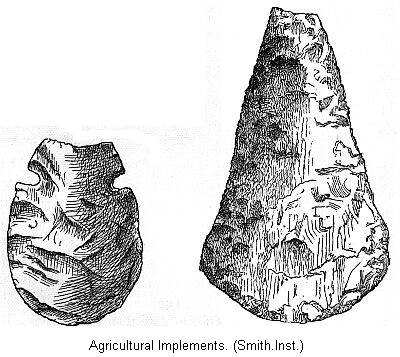
In a few cases copper tools have been
recovered which may have served for digging in the ground, but in
most cases their art furnished them nothing higher than spades,
shovels, picks, and hoes made of stone, horn, bone, and probably
wood. In this cut are specimens of such agricultural tools. These
were doubtless furnished with handles of wood. The notched one
was perhaps provided with a handle at right angles to it, so as
to constitute a hoe. That we are right in regarding these
implements as agricultural tools, is shown not only by their
large size, but also by the traces of wear discovered on them. We
must admit, however, that agriculture carried on with such tools
as these, must have been in a comparatively rude state.
In this connection we must refer to the garden
beds noticed in some places. We read that in Western Michigan the
so-called garden beds are a distinguishing feature of the ancient
occupation, often covering many acres in a place, in a great
variety of forms, both regular and grotesque.101 These seem from the above account to
be very similar to the garden beds of Wisconsin. Dr. Lapham tells
us that in the latter State they consist of low, broad, parallel
ridges, as if corn had been planted in drills.
The average four feet in width, and the depth
of the walk between them is six inches. Traces of this kind of
cultivation are found in various parts of the State. We are also
referred to the presence of garden mounds in Missouri, but in
this case the low mounds are of the same mysterious class that
Prof. Forshey says occur by millions in the South-west, and may
not be the work of man. Just what the connection is between the
garden beds and the Mound Builders is hard to determine. Mr.
Lapham thinks that those in Wisconsin were certainly later in
date than the mounds. He observed that they were frequently
constructed right across the works of the Mound Builders. This
would seem to imply that the makers were not one and the same
people.
As to the government and religion of the Mound
Builders, all is conjecture. On both of these points a great deal
has been assumed, but when we try to find out the grounds on
which these theories rest we quickly see how little real
foundation there is for any knowledge on this subject. If we are
right in our views as to the effigy mounds of Wisconsin, then a
sort of animal worship prevailed. Whether the great inclosures in
the Scioto Valley were of a religious nature or not is very
doubtful. The great serpent mound was probably an object of
worship. The assertion is quite frequently made that the Mound
Builders were sun worshipers, which may be correct, but we must
observe that we have no proofs of it in the works they have left.
We judge it to be true only because sun-worship was probably a
part of the religion of a large proportion of the Indian race,
and because we find special proofs of its existence among some of
the Southern Indians who are supposed to be closely related to
the Mound Builders.
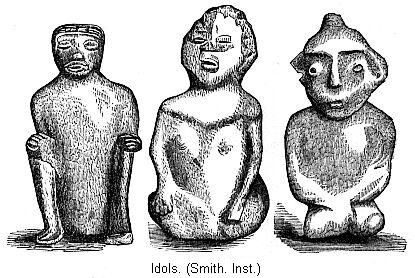
As we approach the South, we meet with what
are supposed to be rude and uncouth idols, but they have not been
found under such circumstances as to make it positive that they
belonged to the Mound Builders. In this illustration we have two
idols, considered to be genuine relics of the stone-grave people
of Tennessee. The first one is an Aztec idol found at Cholula,
and introduced here simply for comparison. What position these
idols held in connection with the religion of the race, we are
not prepared to say.
Similar remarks might be made as to the system
of government. A number of writers, taking into account the
immense labor involved in constructing some of the works, have
insisted that the people must have lived under a despotic form of
government, one in which the state had unlimited power over the
lives and fortunes of its subjects.102
There is no real foundation for such views,
and we think they are misleading. No one doubts but that the
Mound Builders were living in a tribal state of society. If so,
they doubtless had the usual subdivisions of a tribe. This point
we remember afforded us some insight into the meaning of the
effigy mounds of Wisconsin.
This would imply the government by the
council, and while the rulers may have been hereditary, the
officers of the tribe were probably elective, and could be
deposed for cause. We do not mean to assert that this is an exact
picture of the state of government of the Mound Builders, because
our knowledge on this point is not sufficient to make such a
positive statement, but it is far more likely to be true than the
picture of a despotic government, ruling from some capital seat a
large extent of country, holding a court with barbaric pomp and
circumstances such as some writers would have us believe.
We hope our readers have not been wearied by
this somewhat extended investigation of the Mound Builders. Every
storm that beats upon their works tends to level them. The
demands of our modern life are fast obliterating the remaining
monuments and, indeed, it is now only those which are situated in
favorable localities, or are massive in construction, that are
left for our inspection. But these nearly obliterated records of
the past are of more than passing interest to us as monuments of
the prehistoric times of our own country. We wander over these
ruins and find much to interest us, much to excite our curiosity.
The purposes of many are utterly unknown. Some, by their great
proportions, awaken in us feelings of admiration for the
perseverance and energy of their builders. But when we
investigate the objects of stone, of clay, and of copper this
people left behind them, we notice how hard it is to draw a
dividing line between them and the Indians.
In fact, there is no good reason for
separating them from the Indian race as a whole. We do not mean
to say that they were not, in many respects, different from the
tribes found in the same section of the country by the early
explorers, though, we ought, perhaps, to confine this remark to
the central portion of the country occupied by these ancient
remains. But the American of to-day differs from the American of
early Colonial times. The miserable natives of Southern
California were Indians, but very different indeed from the
ambitious, warlike Iroquois, who displayed so much statesmanship
in the formation of their celebrated league. In another chapter
we shall discuss this part of our subject, as well as the
question of the antiquity of the ruins.
REFERENCES
- (1) The manuscript of this chapter was submitted to Prof. F.
W. Putnam, curator of the Peabody Museum of Archæology and
Ethnology, Harvard University, for criticism.
- (2) Conant's "Footprints of Vanished Races," p. 122.
- (3) Force: "Some Considerations on the Mound Builders," p.
64; "Am. Antiquarian," March, 1884, pp. 93-4; "10th Annual
Report, Peabody Museum," p. 11.
- (4) Short's "North Americans of Antiquity", p. 28.
- (5) Squier and Davis's "Ancient Monuments," p. 105.
- (6) Foster's "Prehistoric Paces," p. 148.
- (7) Squier's "Aboriginal Monuments of New York," Smithsonia
Contribution No. 11, p. 83.
- (8) Squier's "Aboriginal Monuments of New York," Smithsonia
Contribution No. 11, p. 87.
- (9) Foster's "Prehistoric Races," p. 121.
- (10) "They are numbered by millions." Ibid.
- (11) Prof. Forshey could frame no satisfactory hypothesis of
their origin. Ibid, p. 122.
- (12) "Native Races," Vol. IV, pp. 739 and 740.
- (13) Smithsonian Rep., 1870, p. 406.
- (14) Narrative of U.S. exploring expedition during the years
1838-42, Vol. IV, p. 334.
- (15) Prof. Gibbs in Frank Leslie's Monthly, August,
1883.
- (16) "Ancient Monuments," p. 139.
- (17) Jones's "Explorations in Tennessee," p. 15.
- (18) "Ancient Monuments," p. 143. Explorers for Bureau of
Ethnology so report it in the South. Prof. Putnam, who has
certainly had great experience, says he has always found the
layers to be horizontal.
- (19) "Sixteenth Annual Report Peabody Museum," p, 171. An
ornament shaped to resemble the head of a wood-pecker, made of
gold, derived from some Spanish source, was found in a mound in
Florida. This particular mound must have been erected after the
discovery of America. ("Smithsonian Report," 1877, p. 298, et
seq.)
- (20) "Sixteenth and Seventeenth Report Peabody Museum." These
ornaments were made of hammered iron. This is the first time that
native iron has been found in the mounds. (Putnam.)
- (21) "Prehistoric Races," p. 178.
- (22) J. E. Stevens's Paper, read before the Muscatine Academy
of Science, Dec., 1878.
- (23) That this was at any rate sometimes the case See
"Ancient Monuments," p. 159.
- (24) "Peabody Museum Reports," Vol. II, p. 58.
- (25) Jones's "Explorations in Tennessee," p. 15. See also
"First An. Rep. Bureau of Ethnology," p. 198.
- (26) "Ancient Monuments," p. 169. See also note on same page
for another account of a larger number of skeletons.
- (27) Short's "North Americans of Antiquity," App. A.
- (28) James's "Popular Science," File 1883, p. 445.
- (29) "Ancient Monuments," p. 173.
- (30) "Ancient Monuments," p. 74.
- (31) "Views of Louisiana."
- (32) This cut represents the mound as it probably was before
the outlines were destroyed by cultivation. It is based on a
model prepared by Dr. Patrick for the Peabody Museum.
- (33) "Peabody Museum Report," Vol. II, p.473. As this may
include some of the wash from the mound, perhaps it would be
better to give the real area of the base as over twelve
acres.
- (34) That is, if we follow the plan.
- (35) "Prehistoric Races," p. 107.
- (36) "Ancient Monuments," p. 174.
- (37) Pickett's "History of Alabama," Vol. I., p. 301.
- (38) Carr's "Mounds of the Mississippi Valley," pp. 91, 92;
note, 103.
- (39) "Ancient Monuments," p. 117. Note.—For the
statement made in this text we are under obligation to Prof.
Thomas, of the Bureau of Ethnology, who, in answer to a letter of
inquiry, kindly furnished the information.
- (40) "Am. Antiquarian," March, 1884, p. 99.
- (41) It may be that no mounds were built for signaling
purposes alone. The work of erecting mounds was so great that it
is quite likely they were always erected for some other purpose,
and used only secondarily for signal purposes. Such is shown to
be the case with many of the signal mounds in Ohio. Such is the
opinion of Mr. MacLean, who has made extensive researches.
- (42) Force's "Some Consideration of the Mound Builders," p.
65.
- (43) Similar effigy mounds have been recently observed in
Minnesota, but they have not yet been described. (Putnam.)
- (44) Peet's American Antiquarian, May, 1884, p.
184.
- (45) Peet's American Antiquarian, January, 1884. We
are indebted to the writings of Mr. Peet in this periodical for
the months of January, May, and July, 1884, for many interesting
facts in reference to the effigy mounds. He has studied them more
than any other person, and his conclusions are consequently of
great value.
- (46) Peet's "Emblematic Mounds and Totem System of the Indian
Tribes."
- (47) "Ancient Monuments," p. 40.
- (48) American Antiquarian, January, 1883.
- (49) Putnam, in "Proceedings of American Antiquarian
Society," 1884.
- (50) Peet's "Emblematic Mounds and Totem System of the Indian
Tribes."
- (51) Abbott's "Primitive Industry," p. 383.
- (52) Peet's "Military Architecture of the Emblematic Mound
Builders."
- (53) "Smithsonian Report," 1877, p. 278, et seq.
- (54) "Ancient Monuments," p. 97; American Antiquarian,
January, 1883, p. 77.
- (55) This information is communicated by Mr. L. N. Tower, a
gentleman in the employ of C. "&" N. W. E. R., at Tracy,
Minn., who, at the request of the writer visited this locality,
made measurements, etc.
- (56) American Antiquarian, November, 1884, p.
403.
- (57) The dimensions of this figure vary. Mr. MacLean's survey
makes the entire length of the serpent part eleven hundred and
sixteen feet; the distance between the extended jaws, one hundred
feet. The oval figure is one hundred and thirteen feet long by
fifty feet wide. The frog or head portion is fifty-five feet. Mr.
Squier says, "The entire length, if extended, would be not less
than one thousand feet." Mr. Putnam's measurements make it
fourteen hundred and fifteen feet. The writer would state that he
visited this effigy in the summer of 1884. Though there but a
very short time, and not prepared to make careful measurements,
he did notice some points in which the illustrations, previously
given, are certainly wrong. The oval is not at the very extremity
of the cliff. The little projections generally called ears of the
serpent are not at right angles to the body, but incline
backwards. The convolutions of the serpent's body bend back and
forth quite across the surface of the ridge.
- (58) Schmuckers.
- (59) "Ancient Monuments," p. 47.
- (60) Foster's "Prehistoric Races," p. 175.
- (61) "Contributions North American Ethnology," Vol. IV, p.
210. A cut of this "restored" pueblo is there given.
- (62) See discussion of this subject in "Proceedings of Am.
Antiq. Society," Oct., 1883.
- (63) "Peabody Museum Reports," Vol. II, p. 205.
- (64) "Ancient Monuments," p. 47.
- (65) Peet: "The Mound Builders."
- (66) "Ancient Monuments," p. 53.
- (67) Force: "Some Considerations on the Mound Builders," p.
64.
- (68) "Archæologia Americana," Vol. I, p. 129.
- (69) For words at Newark, consult "Ancient Monuments," p. 67,
et seq. "American Antiquarian," July, 1882.
- (70) "Ancient Monuments," p. 74.
- (71) "Ancient Monuments," p. 88.
- (72) Mr. Putnam visited the work a few years since, and came
to the conclusion that the larger and old openings were part of
the original design, and that they were places where it was
easier to put up log structures than earthen walls. Just such
openings occur in the massive stone wall around Fort Hill, in
Highland County. A few of the openings at Fort Ancient he thinks
are unquestionably of recent origin, in order to drain the holes
inside the embankments.
- (73) Cincinnati Quart. Journal Science, 1874, p.
294.
- (74) Peet: "The Mound Builders."
- (75) Peet's "Mound Builders:" "If the reader will compare
some of these last cuts with that of the fortified camp at Cissbury, Eng., p. 183,
he will see how similar this last work is to those just
mentioned. Perhaps the real lesson to be learned is that rude
people, whether Indians, Mound Builders, or Celts, resorted to
about the same method of defense."
- (76) "Antiquarian Research," p. 89.
- (77) Conant's "Footprints of Vanished Races," p. 15, et
seq. Mr. Conant refers to Mr. Pidgeon's work in such a way as
to give the impression that he was convinced of the genuineness
of his account.
- (78) "Traditions of Decodah," p. 89, et seq.
- (79) "Antiquarian Research," p. 190.
- (80) "The American Indian, so far as known, without the
exception of a single tribe, worshiped the sun." Carr's "Mounds
of the Mississippi Valley," p. 56.
- (81) Conant's "Footprints of Vanished Races," p. 60.
- (82) Ibid., p. 32. If the explorers are really satisfied this
was a walled town, it ought to throw some light on the inclosures
in the Ohio Valley.
- (83) Conant's "Footprints of Vanished Races," p. 35.
- (84) Conant's "Footprints of Vanished Races," p. 77.
- (85) Vol. III, p. 290, et seq.
- (86) Morgan's "Ancient Society," p. 11.
- (87) "Ancient Monuments," p. 210; also Peet: "The Mound
Builders." "Their relics are marked by a peculiar finish."
- (88) Rau's "Anthropological Research."
- (89) "Proceedings Am. Antiq. Society," April, 1877, p.
61.
- (90) "Smithsonian Contribution to Knowledge," Vol. XIII.
- (91) Abbott's "Primitive Industry," p. 315.
- (92) "Annual Report of Bureau of Ethnology," 1880-1, p. 123,
et seq.
- (93) In the "Annual Report of Bureau of Ethnology," for
1880-1, Mr. Henshaw has very fully discussed these mound-pipes,
and shown that Messrs. Squier and Davis wore mistaken in a number
of their identifications of the animal forms. He concludes there
"are no representations of birds or animals not indigenous to the
Mississippi Valley."
- (94) The recent discoveries by Putnam and Metz, in the
Altar-mounds in the Little Miami Valley, have brought to light
many interesting and important sculptures in stone and
terra-cotta, which, as works of art, are in some respects
superior to those from the Scioto Valley, but as they have not
yet been figured, we can only refer to them here in this brief
note.
- (95) "Number Eight," Mound City, near Chillicothe, Ohio.
"Ancient Monuments," p. 152.
- (96) Rau: "Anthropological Subjects," p. 130.
- (97) Morgan's "Ancient Society," p. 12.
- (98) American Antiquarian, 1879, p. 64.
- (99) McAdams: American Antiquarian, 1880, p. 140.
- (100) "Smithsonian Report," 1866. We have gathered these
points for comparison from Dr. Rau's article in that report.
- (101) Bella Hubbard, American Antiquarian, 1876, p.
219.
- (102) Foster's "Prehistoric Races," p. 346.
Chapter IX: Early Man in America.
Chapter XI: The Pueblo Country.
 PAST of our race is
irradiated here and there by the light of science sufficiently to
enable us to form quite vivid conceptions of vanished peoples. As
the naturalist, from the inspection of a single bone, is enabled
to determine the animal from which it was derived, though there
be no longer a living representative, so the archæologist,
by the aid of fragmentary remains, is able to tell us of manners
and times now long since removed. In the words of another: "The
scientist to-day passes up and down the valleys, and among the
relics and bones of vanished people, and as he touches them with
the magic wand of scientific induction, these ancient men stand
upon their feet, revivified, rehabilitated, and proclaim with
solemn voice the story of their nameless tribe or race, the
contemporaneous animals, and physical appearance of the earth
during those prehistoric ages."2
PAST of our race is
irradiated here and there by the light of science sufficiently to
enable us to form quite vivid conceptions of vanished peoples. As
the naturalist, from the inspection of a single bone, is enabled
to determine the animal from which it was derived, though there
be no longer a living representative, so the archæologist,
by the aid of fragmentary remains, is able to tell us of manners
and times now long since removed. In the words of another: "The
scientist to-day passes up and down the valleys, and among the
relics and bones of vanished people, and as he touches them with
the magic wand of scientific induction, these ancient men stand
upon their feet, revivified, rehabilitated, and proclaim with
solemn voice the story of their nameless tribe or race, the
contemporaneous animals, and physical appearance of the earth
during those prehistoric ages."2








 This cut represents the mound preserved in the park at Marietta.
It is ten feet high, one hundred and eighty-eight feet long, by
one hundred and thirty-two feet wide. The platform on the top has
an area of about half an acre. Graded ways lead up on each of the
four sides. These grades are twenty-five feet wide, and sixty
feet long.
This cut represents the mound preserved in the park at Marietta.
It is ten feet high, one hundred and eighty-eight feet long, by
one hundred and thirty-two feet wide. The platform on the top has
an area of about half an acre. Graded ways lead up on each of the
four sides. These grades are twenty-five feet wide, and sixty
feet long.




 Effigy mounds are almost exclusively confined to the State of
Wisconsin. We, indeed, find effigy mounds in other sections, but
they are of rare occurrence.
Effigy mounds are almost exclusively confined to the State of
Wisconsin. We, indeed, find effigy mounds in other sections, but
they are of rare occurrence. Our next cut represents the famous elephant mound of Wisconsin,
on the strength of which a number of fair theories have been
given relating to the knowledge of the mastodon by the builders
of the mound, and its consequent antiquity. It now bears some
resemblance to an elephant, but we learn that the trunk was
probably produced by the washing of the banks and, from the same
cause, a projection above the head, supposed to represent horns,
has disappeared. Taking these facts into consideration, it is
quite as likely that it represented a buffalo.
Our next cut represents the famous elephant mound of Wisconsin,
on the strength of which a number of fair theories have been
given relating to the knowledge of the mastodon by the builders
of the mound, and its consequent antiquity. It now bears some
resemblance to an elephant, but we learn that the trunk was
probably produced by the washing of the banks and, from the same
cause, a projection above the head, supposed to represent horns,
has disappeared. Taking these facts into consideration, it is
quite as likely that it represented a buffalo.



 Our next cut represents a wild goose with a long neck and beak
followed by a duck with a short neck, flying towards the
lake.
Our next cut represents a wild goose with a long neck and beak
followed by a duck with a short neck, flying towards the
lake.






 The more usual combination was that of a square and a
circle. An example is given in this cut, which is a plan on a
very small scale, of works which formerly existed in Circleville.
One peculiar feature about this work was that a double wall
formed the circle, with a ditch between the two walls. In the
next cut we notice a peculiar combination of these two figures.
The square is inclosed within the circle. Whatever we may
ultimately decide as to the larger works, it would seem as if
this could only be explained as in the nature of a religious
work. We can see no reason for constructing a defensive work, or
inclosing a village, or erecting foundations for houses of such a
shape as this. They must have been in some way connected with the
superstitions of the people.
The more usual combination was that of a square and a
circle. An example is given in this cut, which is a plan on a
very small scale, of works which formerly existed in Circleville.
One peculiar feature about this work was that a double wall
formed the circle, with a ditch between the two walls. In the
next cut we notice a peculiar combination of these two figures.
The square is inclosed within the circle. Whatever we may
ultimately decide as to the larger works, it would seem as if
this could only be explained as in the nature of a religious
work. We can see no reason for constructing a defensive work, or
inclosing a village, or erecting foundations for houses of such a
shape as this. They must have been in some way connected with the
superstitions of the people.
 A peculiar feature is also noticed in reference to some
of the smaller circles in this section. The cut at left
illustrates it. The circle has a ditch interior to the
embankment, and also a broad embankment of about the same height
with the outer wall, interior to the ditch, running about
half-way around the circle. A short distance from the circle was
one of those elevated squares, one hundred and twenty feet square
at the base, and nine feet high.
A peculiar feature is also noticed in reference to some
of the smaller circles in this section. The cut at left
illustrates it. The circle has a ditch interior to the
embankment, and also a broad embankment of about the same height
with the outer wall, interior to the ditch, running about
half-way around the circle. A short distance from the circle was
one of those elevated squares, one hundred and twenty feet square
at the base, and nine feet high.
 In the center is an effigy-mound, represented by this
cut. It represents a bird on the wing, and is called the Eagle
Mound. The long mound in the body of the bird has been opened,
and it was found to contain an altar, such as has been already
described. Was this a place of sacrifice, and did this wall
inclose a sacred area? Our question remains unanswered. We can
dig in the mounds, and wander over the embankments, but the
secret of the builders eludes us.
In the center is an effigy-mound, represented by this
cut. It represents a bird on the wing, and is called the Eagle
Mound. The long mound in the body of the bird has been opened,
and it was found to contain an altar, such as has been already
described. Was this a place of sacrifice, and did this wall
inclose a sacred area? Our question remains unanswered. We can
dig in the mounds, and wander over the embankments, but the
secret of the builders eludes us.




























